ENCYCLOPEDIC ENTRY
Photosynthesis.
Photosynthesis is the process by which plants use sunlight, water, and carbon dioxide to create oxygen and energy in the form of sugar.

Loading ...
Learning materials, instructional links.
- Photosynthesis (Google doc)
Most life on Earth depends on photosynthesis .The process is carried out by plants, algae, and some types of bacteria, which capture energy from sunlight to produce oxygen (O 2 ) and chemical energy stored in glucose (a sugar). Herbivores then obtain this energy by eating plants, and carnivores obtain it by eating herbivores.
The process
During photosynthesis, plants take in carbon dioxide (CO 2 ) and water (H 2 O) from the air and soil. Within the plant cell, the water is oxidized, meaning it loses electrons, while the carbon dioxide is reduced, meaning it gains electrons. This transforms the water into oxygen and the carbon dioxide into glucose. The plant then releases the oxygen back into the air, and stores energy within the glucose molecules.
Chlorophyll
Inside the plant cell are small organelles called chloroplasts , which store the energy of sunlight. Within the thylakoid membranes of the chloroplast is a light-absorbing pigment called chlorophyll , which is responsible for giving the plant its green color. During photosynthesis , chlorophyll absorbs energy from blue- and red-light waves, and reflects green-light waves, making the plant appear green.
Light-dependent Reactions vs. Light-independent Reactions
While there are many steps behind the process of photosynthesis, it can be broken down into two major stages: light-dependent reactions and light-independent reactions. The light-dependent reaction takes place within the thylakoid membrane and requires a steady stream of sunlight, hence the name light- dependent reaction. The chlorophyll absorbs energy from the light waves, which is converted into chemical energy in the form of the molecules ATP and NADPH . The light-independent stage, also known as the Calvin cycle , takes place in the stroma , the space between the thylakoid membranes and the chloroplast membranes, and does not require light, hence the name light- independent reaction. During this stage, energy from the ATP and NADPH molecules is used to assemble carbohydrate molecules, like glucose, from carbon dioxide.
C3 and C4 Photosynthesis
Not all forms of photosynthesis are created equal, however. There are different types of photosynthesis, including C3 photosynthesis and C4 photosynthesis. C3 photosynthesis is used by the majority of plants. It involves producing a three-carbon compound called 3-phosphoglyceric acid during the Calvin Cycle, which goes on to become glucose. C4 photosynthesis, on the other hand, produces a four-carbon intermediate compound, which splits into carbon dioxide and a three-carbon compound during the Calvin Cycle. A benefit of C4 photosynthesis is that by producing higher levels of carbon, it allows plants to thrive in environments without much light or water. The National Geographic Society is making this content available under a Creative Commons CC-BY-NC-SA license . The License excludes the National Geographic Logo (meaning the words National Geographic + the Yellow Border Logo) and any images that are included as part of each content piece. For clarity the Logo and images may not be removed, altered, or changed in any way.
Media Credits
The audio, illustrations, photos, and videos are credited beneath the media asset, except for promotional images, which generally link to another page that contains the media credit. The Rights Holder for media is the person or group credited.
Production Managers
Program specialists, last updated.
March 20, 2024
User Permissions
For information on user permissions, please read our Terms of Service. If you have questions about how to cite anything on our website in your project or classroom presentation, please contact your teacher. They will best know the preferred format. When you reach out to them, you will need the page title, URL, and the date you accessed the resource.
If a media asset is downloadable, a download button appears in the corner of the media viewer. If no button appears, you cannot download or save the media.
Text on this page is printable and can be used according to our Terms of Service .
Interactives
Any interactives on this page can only be played while you are visiting our website. You cannot download interactives.
Related Resources
This page has been archived and is no longer updated
Photosynthetic Cells
Cells get nutrients from their environment, but where do those nutrients come from? Virtually all organic material on Earth has been produced by cells that convert energy from the Sun into energy-containing macromolecules. This process, called photosynthesis, is essential to the global carbon cycle and organisms that conduct photosynthesis represent the lowest level in most food chains (Figure 1).
What Is Photosynthesis? Why Is it Important?
Most living things depend on photosynthetic cells to manufacture the complex organic molecules they require as a source of energy. Photosynthetic cells are quite diverse and include cells found in green plants, phytoplankton, and cyanobacteria. During the process of photosynthesis, cells use carbon dioxide and energy from the Sun to make sugar molecules and oxygen. These sugar molecules are the basis for more complex molecules made by the photosynthetic cell, such as glucose. Then, via respiration processes, cells use oxygen and glucose to synthesize energy-rich carrier molecules, such as ATP, and carbon dioxide is produced as a waste product. Therefore, the synthesis of glucose and its breakdown by cells are opposing processes.
However, photosynthesis doesn't just drive the carbon cycle — it also creates the oxygen necessary for respiring organisms. Interestingly, although green plants contribute much of the oxygen in the air we breathe, phytoplankton and cyanobacteria in the world's oceans are thought to produce between one-third and one-half of atmospheric oxygen on Earth.
What Cells and Organelles Are Involved in Photosynthesis?
Chlorophyll A is the major pigment used in photosynthesis, but there are several types of chlorophyll and numerous other pigments that respond to light, including red, brown, and blue pigments. These other pigments may help channel light energy to chlorophyll A or protect the cell from photo-damage. For example, the photosynthetic protists called dinoflagellates, which are responsible for the "red tides" that often prompt warnings against eating shellfish, contain a variety of light-sensitive pigments, including both chlorophyll and the red pigments responsible for their dramatic coloration.
What Are the Steps of Photosynthesis?
Photosynthesis consists of both light-dependent reactions and light-independent reactions . In plants, the so-called "light" reactions occur within the chloroplast thylakoids, where the aforementioned chlorophyll pigments reside. When light energy reaches the pigment molecules, it energizes the electrons within them, and these electrons are shunted to an electron transport chain in the thylakoid membrane. Every step in the electron transport chain then brings each electron to a lower energy state and harnesses its energy by producing ATP and NADPH. Meanwhile, each chlorophyll molecule replaces its lost electron with an electron from water; this process essentially splits water molecules to produce oxygen (Figure 5).
Once the light reactions have occurred, the light-independent or "dark" reactions take place in the chloroplast stroma. During this process, also known as carbon fixation, energy from the ATP and NADPH molecules generated by the light reactions drives a chemical pathway that uses the carbon in carbon dioxide (from the atmosphere) to build a three-carbon sugar called glyceraldehyde-3-phosphate (G3P). Cells then use G3P to build a wide variety of other sugars (such as glucose) and organic molecules. Many of these interconversions occur outside the chloroplast, following the transport of G3P from the stroma. The products of these reactions are then transported to other parts of the cell, including the mitochondria, where they are broken down to make more energy carrier molecules to satisfy the metabolic demands of the cell. In plants, some sugar molecules are stored as sucrose or starch.
This page appears in the following eBook
Topic rooms within Cell Biology

Within this Subject (25)
- Basic (25)
Other Topic Rooms
- Gene Inheritance and Transmission
- Gene Expression and Regulation
- Nucleic Acid Structure and Function
- Chromosomes and Cytogenetics
- Evolutionary Genetics
- Population and Quantitative Genetics
- Genes and Disease
- Genetics and Society
- Cell Origins and Metabolism
- Proteins and Gene Expression
- Subcellular Compartments
- Cell Communication
- Cell Cycle and Cell Division
© 2014 Nature Education
- Press Room |
- Terms of Use |
- Privacy Notice |

Visual Browse
It’s a wonderful world — and universe — out there.
Come explore with us!
Science News Explores
Explainer: how photosynthesis works.
Plants make sugar and oxygen with the power of water, carbon dioxide and sunlight
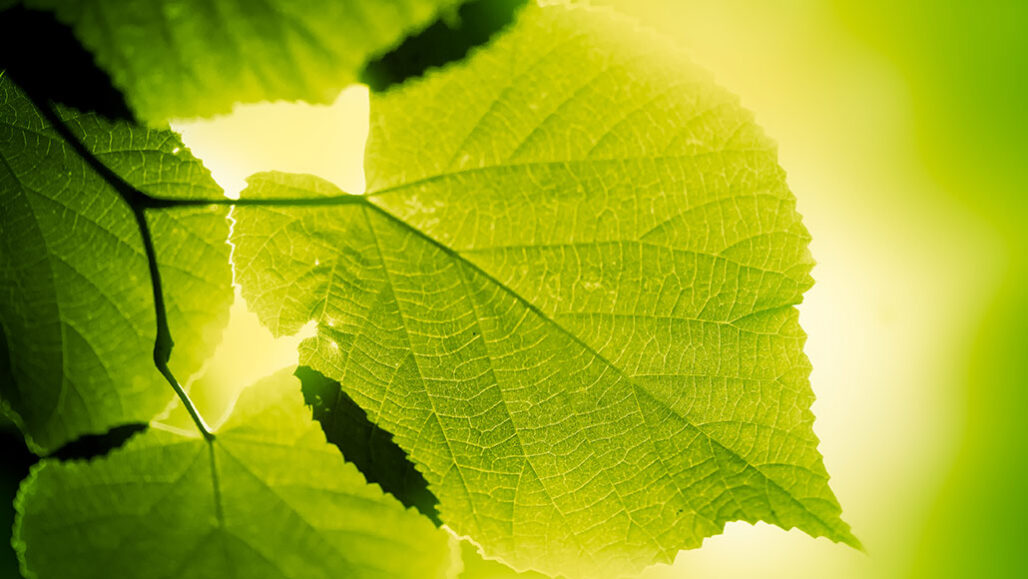
Green plants take in light from the sun and turn water and carbon dioxide into the oxygen we breathe and the sugars we eat.
Jeja/E+/Getty Images
Share this:
- Google Classroom
By Bethany Brookshire
October 28, 2020 at 6:30 am
Take a deep breath. Then thank a plant. If you eat fruit, vegetables, grains or potatoes, thank a plant too. Plants and algae provide us with the oxygen we need to survive, as well as the carbohydrates we use for energy. They do it all through photosynthesis.
Photosynthesis is the process of creating sugar and oxygen from carbon dioxide, water and sunlight. It happens through a long series of chemical reactions. But it can be summarized like this: Carbon dioxide, water and light go in. Glucose, water and oxygen come out. (Glucose is a simple sugar.)
Photosynthesis can be split into two processes. The “photo” part refers to reactions triggered by light. “Synthesis” — the making of the sugar — is a separate process called the Calvin cycle.
Both processes happen inside a chloroplast. This is a specialized structure, or organelle, in a plant cell. The structure contains stacks of membranes called thylakoid membranes. That’s where the light reaction begins.
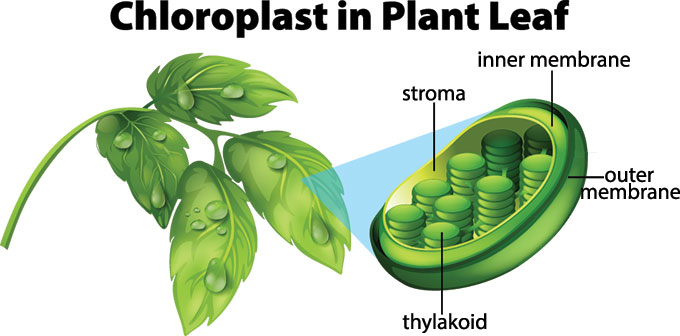
Let the light shine in
When light hits a plant’s leaves, it shines on chloroplasts and into their thylakoid membranes. Those membranes are filled with chlorophyll , a green pigment. This pigment absorbs light energy. Light travels as electromagnetic waves . The wavelength — distance between waves — determines energy level. Some of those wavelengths are visible to us as the colors we see . If a molecule, such as chlorophyll, has the right shape, it can absorb the energy from some wavelengths of light.
Chlorophyll can absorb light we see as blue and red. That’s why we see plants as green. Green is the wavelength plants reflect, not the color they absorb.
While light travels as a wave, it also can be a particle called a photon . Photons have no mass. They do, however, have a small amount of light energy.
When a photon of light from the sun bounces into a leaf, its energy excites a chlorophyll molecule. That photon starts a process that splits a molecule of water. The oxygen atom that splits off from the water instantly bonds with another, creating a molecule of oxygen, or O 2 . The chemical reaction also produces a molecule called ATP and another molecule called NADPH. Both of these allow a cell to store energy. The ATP and NADPH also will take part in the synthesis part of photosynthesis.
Notice that the light reaction makes no sugar. Instead, it supplies energy — stored in the ATP and NADPH — that gets plugged into the Calvin cycle. This is where sugar is made.
But the light reaction does produce something we use: oxygen. All the oxygen we breathe is the result of this step in photosynthesis, carried out by plants and algae (which are not plants ) the world over.
Give me some sugar
The next step takes the energy from the light reaction and applies it to a process called the Calvin cycle. The cycle is named for Melvin Calvin, the man who discovered it.
The Calvin cycle is sometimes also called the dark reaction because none of its steps require light. But it still happens during the day. That’s because it needs the energy produced by the light reaction that comes before it.
While the light reaction takes place in the thylakoid membranes, the ATP and NADPH it produces end up in the stroma. This is the space inside the chloroplast but outside the thylakoid membranes.
The Calvin cycle has four major steps:
- carbon fixation : Here, the plant brings in CO 2 and attaches it to another carbon molecule, using rubisco. This is an enzyme , or chemical that makes reactions move faster. This step is so important that rubisco is the most common protein in a chloroplast — and on Earth. Rubisco attaches the carbon in CO 2 to a five-carbon molecule called ribulose 1,5-bisphosphate (or RuBP). This creates a six-carbon molecule, which immediately splits into two chemicals, each with three carbons.
- reduction : The ATP and NADPH from the light reaction pop in and transform the two three-carbon molecules into two small sugar molecules. The sugar molecules are called G3P. That’s short for glyceraldehyde 3-phosphate (GLIH- sur-AAL-duh-hide 3-FOS-fayt).
- carbohydrate formation : Some of that G3P leaves the cycle to be converted into bigger sugars such as glucose (C 6 H 12 O 6 ).
- regeneration : With more ATP from the continuing light reaction, leftover G3P picks up two more carbons to become RuBP. This RuBP pairs up with rubisco again. They are now ready to start the Calvin cycle again when the next molecule of CO 2 arrives.
At the end of photosynthesis, a plant ends up with glucose (C 6 H 12 O 6 ), oxygen (O 2 ) and water (H 2 O). The glucose molecule goes on to bigger things. It can become part of a long-chain molecule, such as cellulose; that’s the chemical that makes up cell walls. Plants also can store the energy packed in a glucose molecule within larger starch molecules. They can even put the glucose into other sugars — such as fructose — to make a plant’s fruit sweet.
All of these molecules are carbohydrates — chemicals containing carbon, oxygen and hydrogen. (CarbOHydrate makes it easy to remember.) The plant uses the bonds in these chemicals to store energy. But we use the these chemicals too. Carbohydrates are an important part of the foods we eat, particularly grains, potatoes, fruits and vegetables.
More Stories from Science News Explores on Plants

Experiment: Can plants stop soil erosion?
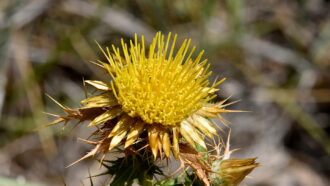
On hot summer days, this thistle stays cool to the touch

Rampaging vines are slowly strangling tropical forests

This urban gardener is mimicking nature to create healthier plants
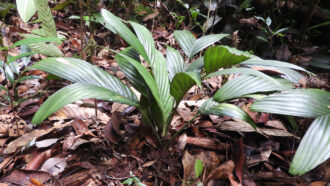
To spy this palm’s blooms and fruits, start digging underground

Here’s why blueberries aren’t blue — but appear to be
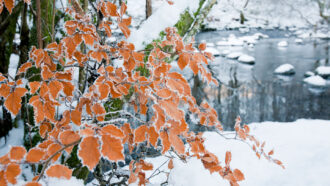
Scientists Say: Marcescence
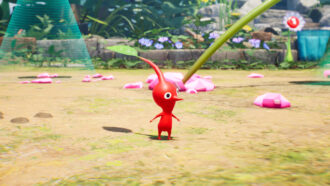
Pikmin ’s plant-animal mashups don’t exist — but sun-powered animals do
Sciencing_Icons_Science SCIENCE
Sciencing_icons_biology biology, sciencing_icons_cells cells, sciencing_icons_molecular molecular, sciencing_icons_microorganisms microorganisms, sciencing_icons_genetics genetics, sciencing_icons_human body human body, sciencing_icons_ecology ecology, sciencing_icons_chemistry chemistry, sciencing_icons_atomic & molecular structure atomic & molecular structure, sciencing_icons_bonds bonds, sciencing_icons_reactions reactions, sciencing_icons_stoichiometry stoichiometry, sciencing_icons_solutions solutions, sciencing_icons_acids & bases acids & bases, sciencing_icons_thermodynamics thermodynamics, sciencing_icons_organic chemistry organic chemistry, sciencing_icons_physics physics, sciencing_icons_fundamentals-physics fundamentals, sciencing_icons_electronics electronics, sciencing_icons_waves waves, sciencing_icons_energy energy, sciencing_icons_fluid fluid, sciencing_icons_astronomy astronomy, sciencing_icons_geology geology, sciencing_icons_fundamentals-geology fundamentals, sciencing_icons_minerals & rocks minerals & rocks, sciencing_icons_earth scructure earth structure, sciencing_icons_fossils fossils, sciencing_icons_natural disasters natural disasters, sciencing_icons_nature nature, sciencing_icons_ecosystems ecosystems, sciencing_icons_environment environment, sciencing_icons_insects insects, sciencing_icons_plants & mushrooms plants & mushrooms, sciencing_icons_animals animals, sciencing_icons_math math, sciencing_icons_arithmetic arithmetic, sciencing_icons_addition & subtraction addition & subtraction, sciencing_icons_multiplication & division multiplication & division, sciencing_icons_decimals decimals, sciencing_icons_fractions fractions, sciencing_icons_conversions conversions, sciencing_icons_algebra algebra, sciencing_icons_working with units working with units, sciencing_icons_equations & expressions equations & expressions, sciencing_icons_ratios & proportions ratios & proportions, sciencing_icons_inequalities inequalities, sciencing_icons_exponents & logarithms exponents & logarithms, sciencing_icons_factorization factorization, sciencing_icons_functions functions, sciencing_icons_linear equations linear equations, sciencing_icons_graphs graphs, sciencing_icons_quadratics quadratics, sciencing_icons_polynomials polynomials, sciencing_icons_geometry geometry, sciencing_icons_fundamentals-geometry fundamentals, sciencing_icons_cartesian cartesian, sciencing_icons_circles circles, sciencing_icons_solids solids, sciencing_icons_trigonometry trigonometry, sciencing_icons_probability-statistics probability & statistics, sciencing_icons_mean-median-mode mean/median/mode, sciencing_icons_independent-dependent variables independent/dependent variables, sciencing_icons_deviation deviation, sciencing_icons_correlation correlation, sciencing_icons_sampling sampling, sciencing_icons_distributions distributions, sciencing_icons_probability probability, sciencing_icons_calculus calculus, sciencing_icons_differentiation-integration differentiation/integration, sciencing_icons_application application, sciencing_icons_projects projects, sciencing_icons_news news.
- Share Tweet Email Print
- Home ⋅
- Science ⋅
- Nature ⋅
- Environment
Why Is Photosynthesis Important for All Organisms?

How Does a Plant Convert Light Energy to Chemical Energy?
Photosynthesis is important to living organisms because it is the number one source of oxygen in the atmosphere. Without photosynthesis, the carbon cycle could not occur, oxygen-requiring life would not survive and plants would die. Green plants and trees use photosynthesis to make food from sunlight, carbon dioxide and water in the atmosphere: It is their primary source of energy. The importance of photosynthesis in our life is the oxygen it produces. Without photosynthesis there would be little to no oxygen on the planet.
TL;DR (Too Long; Didn't Read)
Photosynthesis is important for all living organisms because it provides the oxygen needed by most living creatures for survival on the planet.
Reasons Why Photosynthesis Is Important
- It is the number one source of oxygen in the atmosphere.
- It contributes to the carbon cycle between the earth, the oceans, plants and animals.
- It contributes to the symbiotic relationship between plants, humans and animals.
- It directly or indirectly affects most life on Earth.
- It serves as the primary energy process for most trees and plants.
How Photosynthesis Works
Photosynthesis uses light energy from the sun and carbon dioxide and water in the atmosphere to make food for plants, trees, algae and even some bacteria. It releases oxygen as a byproduct. The chlorophyll in these living organisms, which also contributes to their green hues, absorbs the sunlight and combines it with carbon dioxide to convert these compounds into an organic chemical called adenosine triphosphate (ATP). ATP is crucial in the relationship between energy and living things, and is known as the "energy currency for all life."
Importance of Cellular Respiration to Photosynthesis
Cellular respiration allows all living cells to extract energy in the form of ATP from food and offer that energy for the vital processes of life. All living cells in plants, animals and humans take part in cellular respiration in one form or another. Cellular respiration is a three-step process. In step one, the cytoplasm of the cell breaks down glucose in a process called glycolysis, producing two pyruvate molecules from one glucose molecule and releasing a bit of ATP. In the second step, the cell transports the pyruvate molecules into the mitochondria, the energy center of the cells, without using oxygen, This is known as anaerobic respiration. The third step of cellular respiration involves oxygen and is called aerobic respiration, in which the food energy enters an electron transport chain where it produces ATP.
Cellular respiration in plants is essentially the opposite of photosynthesis. Living creatures breathe in oxygen and release carbon dioxide as a byproduct. A plant uses the carbon dioxide exhaled by animals and humans in combination with the sun's energy during cellular respiration to produce the food that it requires. Plants eventually release oxygen back into the atmosphere, resulting in a symbiotic relationship between plants, animals and humans.
Non-Photosynthetic Plants
While most plants use photosynthesis to produce energy, there are some that are non-photosynthetic. Plants that do not use photosynthesis to produce food are usually parasitic, which means they rely on a host for nutrient generation. Examples include Indian pipe ( Monotropa uniflora ) – also known as the ghost or corpse plant – and beechdrops ( Epifagus americana ), which steals nutrients found in beech tree roots. The Indian pipe plant is a ghostly white color because it contains no chlorophyll. Plants in the fungi kingdom – mushrooms, molds and yeasts – rely on their environment for food instead of photosynthesis.
Related Articles
What is the sun's role in photosynthesis, what provides electrons for the light reactions, how do plants store energy during photosynthesis, organelles involved in photosynthesis, is the krebs cycle aerobic or anaerobic, structural characteristics of blue-green algae, what are the functions of photosynthesis, key differences between c3, c4 and cam photosynthesis, how do plants make their own food, what is produced as a result of photosynthesis, what is the photosynthesis equation, the structure of a eukaryotic cell, what is the role of pigments in photosynthesis, how are photosynthesis & cellular respiration related, difference between heterotrophs & autotrophs, what are the reactants of photosynthesis, why are cells important for living organisms, what are the five subdivisions of kingdoms.
- University of California Santa Barbara: How Does Photosynthesis Affect Other Organisms?
- Columbia University: The Carbon Cycle and Earth's Climate
- State University of New York Cortland: Non-Photosynthetic Plants
- California State University, Sacramento: Kingdom Fungi
About the Author
As a journalist and editor for several years, Laurie Brenner has covered many topics in her writings, but science is one of her first loves. Her stint as Manager of the California State Mining and Mineral Museum in California's gold country served to deepen her interest in science which she now fulfills by writing for online science websites. Brenner is also a published sci-fi author. She graduated from San Diego's Coleman College in 1972.
Find Your Next Great Science Fair Project! GO
5.1 Overview of Photosynthesis
Learning objectives.
- Summarize the process of photosynthesis
- Explain the relevance of photosynthesis to other living things
- Identify the reactants and products of photosynthesis
- Describe the main structures involved in photosynthesis
All living organisms on earth consist of one or more cells. Each cell runs on the chemical energy found mainly in carbohydrate molecules (food), and the majority of these molecules are produced by one process: photosynthesis. Through photosynthesis, certain organisms convert solar energy (sunlight) into chemical energy, which is then used to build carbohydrate molecules. The energy used to hold these molecules together is released when an organism breaks down food. Cells then use this energy to perform work, such as cellular respiration.
The energy that is harnessed from photosynthesis enters the ecosystems of our planet continuously and is transferred from one organism to another. Therefore, directly or indirectly, the process of photosynthesis provides most of the energy required by living things on earth.
Photosynthesis also results in the release of oxygen into the atmosphere. In short, to eat and breathe, humans depend almost entirely on the organisms that carry out photosynthesis.
Link to Learning
Click the following link to learn more about photosynthesis.
Solar Dependence and Food Production
Some organisms can carry out photosynthesis, whereas others cannot. An autotroph is an organism that can produce its own food. The Greek roots of the word autotroph mean “self” ( auto ) “feeder” ( troph ). Plants are the best-known autotrophs, but others exist, including certain types of bacteria and algae ( Figure 5.2 ). Oceanic algae contribute enormous quantities of food and oxygen to global food chains. Plants are also photoautotrophs , a type of autotroph that uses sunlight and carbon from carbon dioxide to synthesize chemical energy in the form of carbohydrates. All organisms carrying out photosynthesis require sunlight.
Heterotrophs are organisms incapable of photosynthesis that must therefore obtain energy and carbon from food by consuming other organisms. The Greek roots of the word heterotroph mean “other” ( hetero ) “feeder” ( troph ), meaning that their food comes from other organisms. Even if the food organism is another animal, this food traces its origins back to autotrophs and the process of photosynthesis. Humans are heterotrophs, as are all animals. Heterotrophs depend on autotrophs, either directly or indirectly. Deer and wolves are heterotrophs. A deer obtains energy by eating plants. A wolf eating a deer obtains energy that originally came from the plants eaten by that deer. The energy in the plant came from photosynthesis, and therefore it is the only autotroph in this example ( Figure 5.3 ). Using this reasoning, all food eaten by humans also links back to autotrophs that carry out photosynthesis.
Everyday Connection
Photosynthesis at the grocery store.
Major grocery stores in the United States are organized into departments, such as dairy, meats, produce, bread, cereals, and so forth. Each aisle contains hundreds, if not thousands, of different products for customers to buy and consume ( Figure 5.4 ).
Although there is a large variety, each item links back to photosynthesis. Meats and dairy products link to photosynthesis because the animals were fed plant-based foods. The breads, cereals, and pastas come largely from grains, which are the seeds of photosynthetic plants. What about desserts and drinks? All of these products contain sugar—the basic carbohydrate molecule produced directly from photosynthesis. The photosynthesis connection applies to every meal and every food a person consumes.
Main Structures and Summary of Photosynthesis
Photosynthesis requires sunlight, carbon dioxide, and water as starting reactants ( Figure 5.5 ). After the process is complete, photosynthesis releases oxygen and produces carbohydrate molecules, most commonly glucose. These sugar molecules contain the energy that living things need to survive.
The complex reactions of photosynthesis can be summarized by the chemical equation shown in Figure 5.6 .
Although the equation looks simple, the many steps that take place during photosynthesis are actually quite complex, as in the way that the reaction summarizing cellular respiration represented many individual reactions. Before learning the details of how photoautotrophs turn sunlight into food, it is important to become familiar with the physical structures involved.
In plants, photosynthesis takes place primarily in leaves, which consist of many layers of cells and have differentiated top and bottom sides. The process of photosynthesis occurs not on the surface layers of the leaf, but rather in a middle layer called the mesophyll ( Figure 5.7 ). The gas exchange of carbon dioxide and oxygen occurs through small, regulated openings called stomata .
In all autotrophic eukaryotes, photosynthesis takes place inside an organelle called a chloroplast . In plants, chloroplast-containing cells exist in the mesophyll. Chloroplasts have a double (inner and outer) membrane. Within the chloroplast is a third membrane that forms stacked, disc-shaped structures called thylakoids . Embedded in the thylakoid membrane are molecules of chlorophyll , a pigment (a molecule that absorbs light) through which the entire process of photosynthesis begins. Chlorophyll is responsible for the green color of plants. The thylakoid membrane encloses an internal space called the thylakoid space. Other types of pigments are also involved in photosynthesis, but chlorophyll is by far the most important. As shown in Figure 5.7 , a stack of thylakoids is called a granum , and the space surrounding the granum is called stroma (not to be confused with stomata, the openings on the leaves).
Visual Connection
On a hot, dry day, plants close their stomata to conserve water. What impact will this have on photosynthesis?
The Two Parts of Photosynthesis
Photosynthesis takes place in two stages: the light-dependent reactions and the Calvin cycle. In the light-dependent reactions , which take place at the thylakoid membrane, chlorophyll absorbs energy from sunlight and then converts it into chemical energy with the use of water. The light-dependent reactions release oxygen from the hydrolysis of water as a byproduct. In the Calvin cycle, which takes place in the stroma, the chemical energy derived from the light-dependent reactions drives both the capture of carbon in carbon dioxide molecules and the subsequent assembly of sugar molecules. The two reactions use carrier molecules to transport the energy from one to the other. The carriers that move energy from the light-dependent reactions to the Calvin cycle reactions can be thought of as “full” because they bring energy. After the energy is released, the “empty” energy carriers return to the light-dependent reactions to obtain more energy. The two-stage, two-location photosynthesis process was discovered by Joan Mary Anderson, whose continuing work over the subsequent decades provided much of our understanding of the process, the membranes, and the chemicals involved.
As an Amazon Associate we earn from qualifying purchases.
This book may not be used in the training of large language models or otherwise be ingested into large language models or generative AI offerings without OpenStax's permission.
Want to cite, share, or modify this book? This book uses the Creative Commons Attribution License and you must attribute OpenStax.
Access for free at https://openstax.org/books/concepts-biology/pages/1-introduction
- Authors: Samantha Fowler, Rebecca Roush, James Wise
- Publisher/website: OpenStax
- Book title: Concepts of Biology
- Publication date: Apr 25, 2013
- Location: Houston, Texas
- Book URL: https://openstax.org/books/concepts-biology/pages/1-introduction
- Section URL: https://openstax.org/books/concepts-biology/pages/5-1-overview-of-photosynthesis
© Jan 8, 2024 OpenStax. Textbook content produced by OpenStax is licensed under a Creative Commons Attribution License . The OpenStax name, OpenStax logo, OpenStax book covers, OpenStax CNX name, and OpenStax CNX logo are not subject to the Creative Commons license and may not be reproduced without the prior and express written consent of Rice University.
- Subscribe to BBC Science Focus Magazine
- Previous Issues
- Future tech
- Everyday science
- Planet Earth
- Newsletters
© Getty Images
Photosynthesis: What is it and how does it work?
Photosynthesis is essential for almost all life, and it’s the primary source of oxygen in the atmosphere.
Holly Spanner
Photosynthesis is all around us. It's happening under our feet, above our heads and in the sunlit zones of aquatic environments. But what exactly is photosynthesis? Why is it so important? And, when did it evolve? Answers to these questions, and more, are below.
For those who missed it, check out these five astonishing plant adaptations or find out whether plants are conscious.
What is photosynthesis?
Photosynthesis is the process by which carbohydrate molecules are synthesised. It's used by plants, algae and certain bacteria to turn sunlight, water and carbon dioxide into oxygen and energy, in the form of sugar. It’s probably the most important biochemical process on the planet.
Essentially, it takes the carbon dioxide expelled by all breathing organisms and reintroduces it into the atmosphere as oxygen.
The rate of photosynthesis is affected by light intensity, the concentration of carbon dioxide, water supply, temperature and availability of minerals. The process takes place entirely in the chloroplasts, and it's the chlorophyll within the chloroplasts that make the photosynthetic parts of a plant green.
Photosynthesis is important too, elsewhere in the biosphere. Both marine and terrestrial plants remove carbon dioxide from the atmosphere, and some of this is precipitated back out, as shells made of calcium carbonate, or buried as organic matter in soil.
Without photosynthesis, the carbon cycle could not occur, and we would soon run out of food. Over time, the atmosphere would lose almost all gaseous oxygen, and most organisms would disappear.
How does photosynthesis work?
Plants require light energy, carbon dioxide, water and nutrients. These ingredients come from both the adjacent atmosphere and the soil.

Plants absorb sunlight through the two top layers of their leaves, the cuticle and epidermis. These layers are thin, so light can travel through them easily. Carbon dioxide is brought in from the atmosphere, and at the same time, water is drawn up from the soil, into the body of the living plant.
Just beneath the cuticle and epidermis are the palisade mesophyll cells. These specialised cells are vertically elongated and arranged closely together to maximise light absorption.
Below the palisade mesophyll cells is the spongy mesophyll tissue, which is loosely packed for efficient gas exchange. As gases move in and out of these cells, they dissolve in a thin layer of water that covers the cells.

Inside the palisade mesophyll cells are the chloroplasts, lots of them . They contain chlorophyll, molecules that don’t absorb green wavelengths of white light. Instead, they reflect it back to us, giving plants their green colour.
Inside the chloroplast is where the magic happens. A light-dependent reaction takes place, where energy from the light waves is absorbed and stored in energy-carrying ATP molecules.
Then, in a light-independent reaction (the Calvin Cycle), ATP is used to make glucose, a source of energy. Water is oxidised, carbon dioxide is reduced, and oxygen is released into the atmosphere.
Oxygen is released via stomata in the leaves, microscopic pores that open to both let in the carbon dioxide, and release oxygen (and water vapour).
What is the equation for photosynthesis?
Photosynthesising organisms form the base of the food chain.
Carbon dioxide + water (with light energy) = glucose + oxygen
As well as the light energy, carbon dioxide and water, plants also need nutrients, which they get from the soil. These nutrients are released again, or recycled, when the plant tissue dies and begins decomposing in the soil.
Oxygen in the form of gas molecules (O 2 ) is actually a by-product of photosynthesis, but it's responsible for the oxygen in the air that keeps us alive. Plants also release energy and water to the atmosphere through respiration.
6CO 2 + 6H 2 O → C 6 H 12 O 6 + 6O 2
The balanced equation takes it a little further. Six carbon dioxide molecules and six water molecules (the reactants) are converted into one sugar molecule (C 6 H 12 O 6) and six oxygen molecules, via the light energy captured by the chlorophyll.
Photosynthesis and the food chain
During photosynthesis, energy passes through the system, and you can think of photosynthesis as an energy flow system, tracing the path of solar energy through the ecosystem. This energy is stored by the primary producers, the photosynthesising organisms. As these organisms are eaten and digested by the primary consumers, chemical energy is released and this is used to power new biochemical reactions.
At each level of energy transformation throughout the food chain, some energy is lost as waste heat. In addition, a significant amount of the energy input to each organism is used in respiration, to maintain the body of that organism. This energy is not stored for use by other organisms higher up the food chain. This is one of the reasons why both the number of organisms and their total quantity of living tissue decrease as you go further up the food chain.
When did photosynthesis start?
The evolution of photosynthesis had immense consequences for the Earth. As organic matter from photosynthetic life was buried in the strata, carbon was removed from the atmosphere allowing oxygen to accumulate.
Evidence suggests that photosynthetic organisms were present around 3.2 to 3.5 billion years ago , in the form of stromatolites. Stromatolites are laminated microbial structures ( generally an alternation between light and dark laminae ), usually formed by cyanobacteria and algae, and are the oldest known fossils, and therefore the earliest evidence of life on Earth.
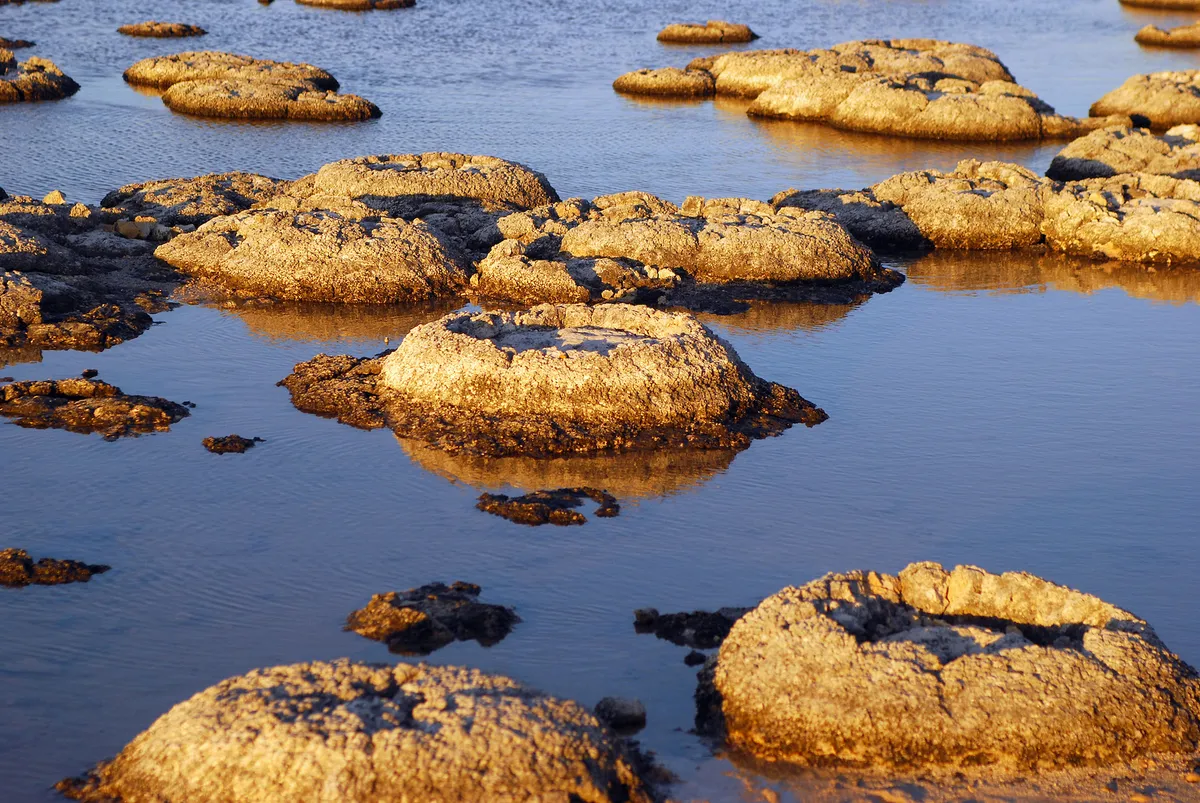
As this early oxygen diffused into the upper atmosphere (the stratosphere), solar radiation transformed the oxygen molecules into ozone, which created the stratospheric ozone layer. And of course, as the ozone layer absorbs most of the Sun's ultraviolet radiation (UV-B), it plays an important role in protecting human health, so it's unlikely that life would have flourished without this protective shield.
- Can any plants live without sunlight?
- Can photosynthesis be recreated in the lab?
- Can any animals photosynthesise?
- Is artificial photosynthesis a promising technology for future energy production?
To submit your questions email us at [email protected] (don't forget to include your name and location)
Share this article
Staff Writer, BBC Science Focus

- Terms & Conditions
- Privacy policy
- Cookies policy
- Code of conduct
- Magazine subscriptions
- Manage preferences
Module 6: Metabolic Pathways
Photosynthesis, identify the basic components and steps of photosynthesis.
The processes in all organisms—from bacteria to humans—require energy. To get this energy, many organisms access stored energy by eating, that is, by ingesting other organisms. But where does the stored energy in food originate? All of this energy can be traced back to photosynthesis.
Photosynthesis is essential to all life on earth; both plants and animals depend on it. It is the only biological process that can capture energy that originates in outer space (sunlight) and convert it into chemical compounds (carbohydrates) that every organism uses to power its metabolism. In brief, the energy of sunlight is captured and used to energize electrons, which are then stored in the covalent bonds of sugar molecules. How long lasting and stable are those covalent bonds? The energy extracted today by the burning of coal and petroleum products represents sunlight energy captured and stored by photosynthesis around 300 million years ago.
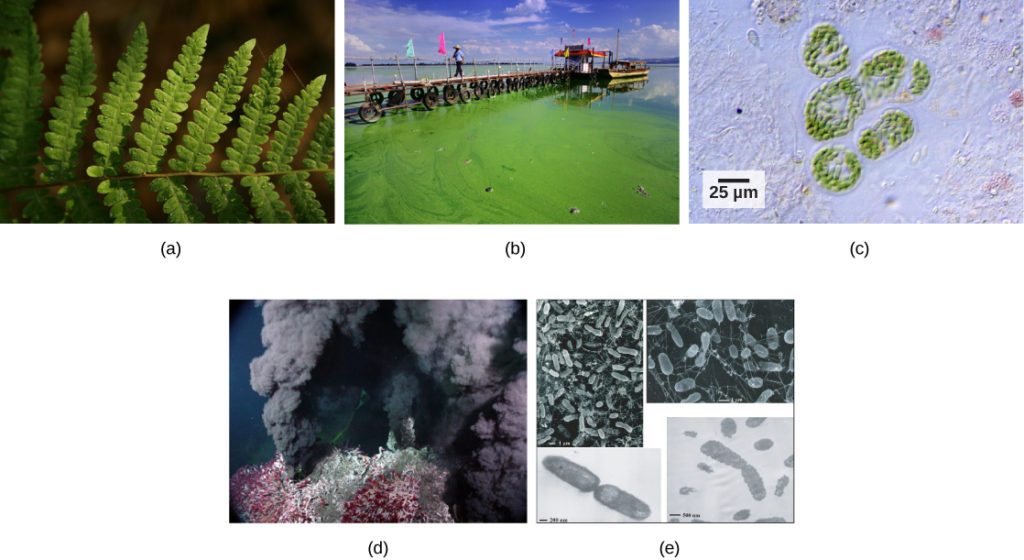
Figure 1. Photoautotrophs including (a) plants, (b) algae, and (c) cyanobacteria synthesize their organic compounds via photosynthesis using sunlight as an energy source. Cyanobacteria and planktonic algae can grow over enormous areas in water, at times completely covering the surface. In a (d) deep sea vent, chemoautotrophs, such as these (e) thermophilic bacteria, capture energy from inorganic compounds to produce organic compounds. The ecosystem surrounding the vents has a diverse array of animals, such as tubeworms, crustaceans, and octopi that derive energy from the bacteria. (credit a: modification of work by Steve Hillebrand, U.S. Fish and Wildlife Service; credit b: modification of work by “eutrophication&hypoxia”/Flickr; credit c: modification of work by NASA; credit d: University of Washington, NOAA; credit e: modification of work by Mark Amend, West Coast and Polar Regions Undersea Research Center, UAF, NOAA)
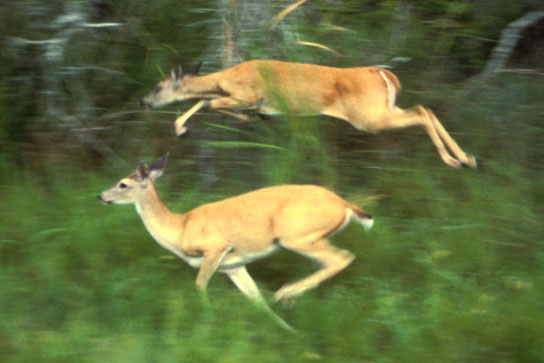
Figure 2. The energy stored in carbohydrate molecules from photosynthesis passes through the food chain. The predator that eats these deer receives a portion of the energy that originated in the photosynthetic vegetation that the deer consumed. (credit: modification of work by Steve VanRiper, U.S. Fish and Wildlife Service)
Plants, algae, and a group of bacteria called cyanobacteria are the only organisms capable of performing photosynthesis (Figure 1). Because they use light to manufacture their own food, they are called photoautotrophs (literally, “self-feeders using light”). Other organisms, such as animals, fungi, and most other bacteria, are termed heterotrophs (“other feeders”), because they must rely on the sugars produced by photosynthetic organisms for their energy needs. A third very interesting group of bacteria synthesize sugars, not by using sunlight’s energy, but by extracting energy from inorganic chemical compounds; hence, they are referred to as chemoautotrophs .
The importance of photosynthesis is not just that it can capture sunlight’s energy. A lizard sunning itself on a cold day can use the sun’s energy to warm up. Photosynthesis is vital because it evolved as a way to store the energy in solar radiation (the “photo” part) as high-energy electrons in the carbon-carbon bonds of carbohydrate molecules (the “synthesis” part). Those carbohydrates are the energy source that heterotrophs use to power the synthesis of ATP via respiration. Therefore, photosynthesis powers 99 percent of Earth’s ecosystems. When a top predator, such as a wolf, preys on a deer (Figure 2), the wolf is at the end of an energy path that went from nuclear reactions on the surface of the sun, to light, to photosynthesis, to vegetation, to deer, and finally to wolf.
Learning Objectives
- Identify the reactants and products of photosynthesis
- Describe the visible and electromagnetic spectrums of light as they applies to photosynthesis
- Describe the light-dependent reactions that take place during photosynthesis
- Identify the light-independent reactions in photosynthesis
Photosynthesis is a multi-step process that requires sunlight, carbon dioxide (which is low in energy), and water as substrates (Figure 3). After the process is complete, it releases oxygen and produces glyceraldehyde-3-phosphate (GA3P), simple carbohydrate molecules (which are high in energy) that can subsequently be converted into glucose, sucrose, or any of dozens of other sugar molecules. These sugar molecules contain energy and the energized carbon that all living things need to survive.
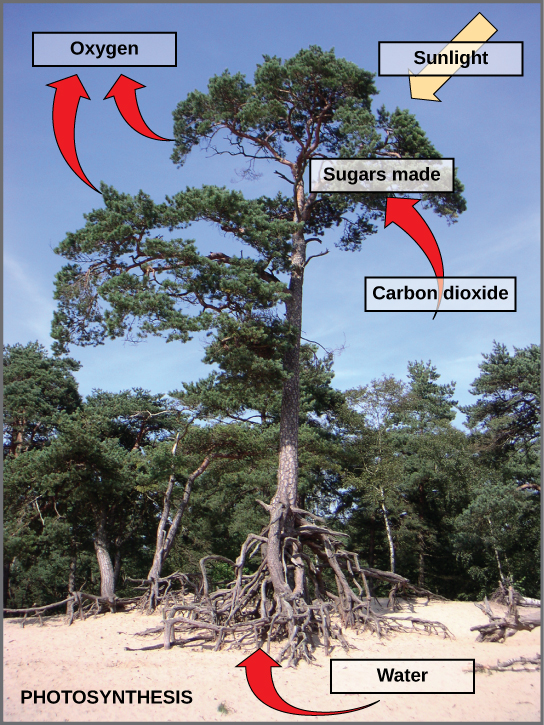
Figure 3. Photosynthesis uses solar energy, carbon dioxide, and water to produce energy-storing carbohydrates. Oxygen is generated as a waste product of photosynthesis.
The following is the chemical equation for photosynthesis (Figure 4):

Figure 4. The basic equation for photosynthesis is deceptively simple. In reality, the process takes place in many steps involving intermediate reactants and products. Glucose, the primary energy source in cells, is made from two three-carbon GA3Ps.
Although the equation looks simple, the many steps that take place during photosynthesis are actually quite complex. Before learning the details of how photoautotrophs turn sunlight into food, it is important to become familiar with the structures involved.
In plants, photosynthesis generally takes place in leaves, which consist of several layers of cells. The process of photosynthesis occurs in a middle layer called the mesophyll . The gas exchange of carbon dioxide and oxygen occurs through small, regulated openings called stomata (singular: stoma), which also play roles in the regulation of gas exchange and water balance. The stomata are typically located on the underside of the leaf, which helps to minimize water loss. Each stoma is flanked by guard cells that regulate the opening and closing of the stomata by swelling or shrinking in response to osmotic changes.
In all autotrophic eukaryotes, photosynthesis takes place inside an organelle called a chloroplast . For plants, chloroplast-containing cells exist in the mesophyll. Chloroplasts have a double membrane envelope (composed of an outer membrane and an inner membrane). Within the chloroplast are stacked, disc-shaped structures called thylakoids . Embedded in the thylakoid membrane is chlorophyll, a pigment (molecule that absorbs light) responsible for the initial interaction between light and plant material, and numerous proteins that make up the electron transport chain. The thylakoid membrane encloses an internal space called the thylakoid lumen . As shown in Figure 5, a stack of thylakoids is called a granum , and the liquid-filled space surrounding the granum is called stroma or “bed” (not to be confused with stoma or “mouth,” an opening on the leaf epidermis).
Practice Question
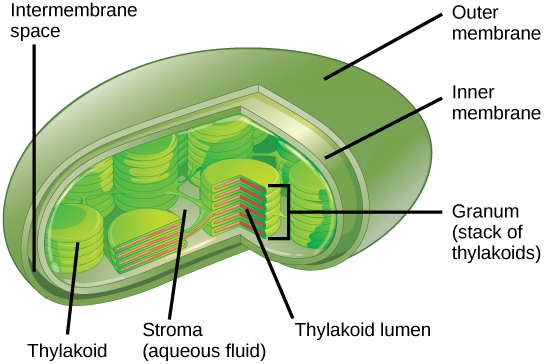
Figure 5. Photosynthesis takes place in chloroplasts, which have an outer membrane and an inner membrane. Stacks of thylakoids called grana form a third membrane layer.
On a hot, dry day, plants close their stomata to conserve water. What impact will this have on photosynthesis?
The Two Parts of Photosynthesis
Photosynthesis takes place in two sequential stages: the light-dependent reactions and the light independent-reactions. In the light-dependent reactions , energy from sunlight is absorbed by chlorophyll and that energy is converted into stored chemical energy. In the light-independent reactions , the chemical energy harvested during the light-dependent reactions drive the assembly of sugar molecules from carbon dioxide. Therefore, although the light-independent reactions do not use light as a reactant, they require the products of the light-dependent reactions to function. In addition, several enzymes of the light-independent reactions are activated by light. The light-dependent reactions utilize certain molecules to temporarily store the energy: These are referred to as energy carriers. The energy carriers that move energy from light-dependent reactions to light-independent reactions can be thought of as “full” because they are rich in energy. After the energy is released, the “empty” energy carriers return to the light-dependent reaction to obtain more energy. Figure 6 illustrates the components inside the chloroplast where the light-dependent and light-independent reactions take place.
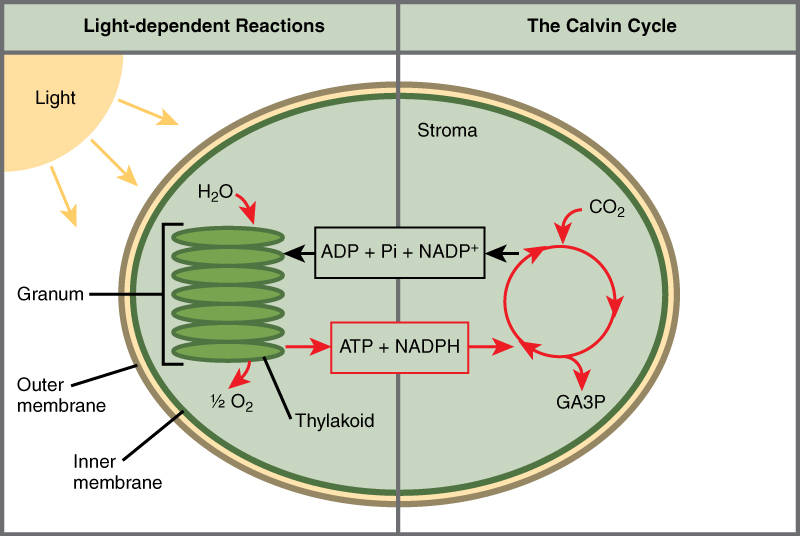
Figure 6. Photosynthesis takes place in two stages: light dependent reactions and the Calvin cycle. Light-dependent reactions, which take place in the thylakoid membrane, use light energy to make ATP and NADPH. The Calvin cycle, which takes place in the stroma, uses energy derived from these compounds to make GA3P from CO 2 .

Photosynthesis at the Grocery Store
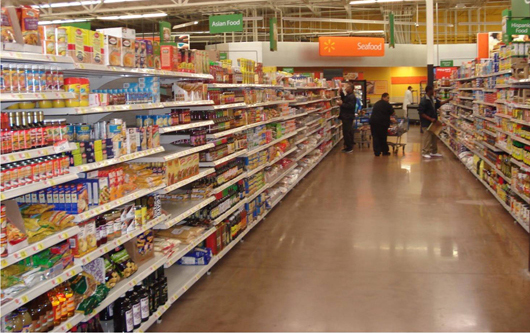
Figure 7. Foods that humans consume originate from photosynthesis. (credit: Associação Brasileira de Supermercados)
Major grocery stores in the United States are organized into departments, such as dairy, meats, produce, bread, cereals, and so forth. Each aisle (Figure 7) contains hundreds, if not thousands, of different products for customers to buy and consume.
Although there is a large variety, each item links back to photosynthesis. Meats and dairy link because the animals were fed plant-based foods. The breads, cereals, and pastas come largely from starchy grains, which are the seeds of photosynthesis-dependent plants. What about desserts and drinks? All of these products contain sugar—sucrose is a plant product, a disaccharide, a carbohydrate molecule, which is built directly from photosynthesis. Moreover, many items are less obviously derived from plants: for instance, paper goods are generally plant products, and many plastics (abundant as products and packaging) can be derived from algae or from oil, the fossilized remains of photosynthetic organisms. Virtually every spice and flavoring in the spice aisle was produced by a plant as a leaf, root, bark, flower, fruit, or stem. Ultimately, photosynthesis connects to every meal and every food a person consumes.
Spectrums of Light
How can light be used to make food? When a person turns on a lamp, electrical energy becomes light energy. Like all other forms of kinetic energy, light can travel, change form, and be harnessed to do work. In the case of photosynthesis, light energy is converted into chemical energy, which photoautotrophs use to build carbohydrate molecules. However, autotrophs only use a few specific components of sunlight.
What Is Light Energy?
The sun emits an enormous amount of electromagnetic radiation (solar energy). Humans can see only a fraction of this energy, which portion is therefore referred to as “visible light.” The manner in which solar energy travels is described as waves. Scientists can determine the amount of energy of a wave by measuring its wavelength, the distance between consecutive points of a wave. A single wave is measured from two consecutive points, such as from crest to crest or from trough to trough (Figure 8).
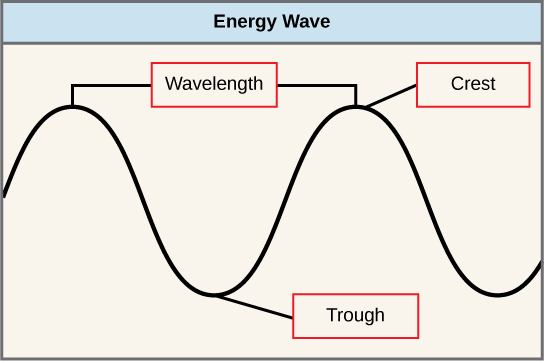
Figure 8. The wavelength of a single wave is the distance between two consecutive points of similar position (two crests or two troughs) along the wave.
Visible light constitutes only one of many types of electromagnetic radiation emitted from the sun and other stars. Scientists differentiate the various types of radiant energy from the sun within the electromagnetic spectrum. The electromagnetic spectrum is the range of all possible frequencies of radiation (Figure 9). The difference between wavelengths relates to the amount of energy carried by them.
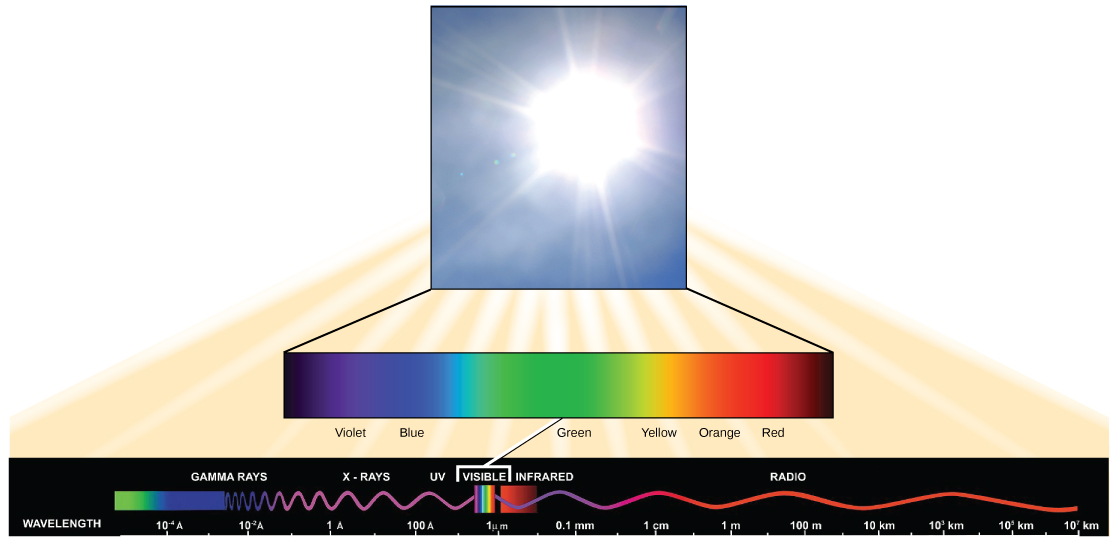
Figure 9. The sun emits energy in the form of electromagnetic radiation. This radiation exists at different wavelengths, each of which has its own characteristic energy. All electromagnetic radiation, including visible light, is characterized by its wavelength.
Each type of electromagnetic radiation travels at a particular wavelength. The longer the wavelength (or the more stretched out it appears in the diagram), the less energy is carried. Short, tight waves carry the most energy. This may seem illogical, but think of it in terms of a piece of moving a heavy rope. It takes little effort by a person to move a rope in long, wide waves. To make a rope move in short, tight waves, a person would need to apply significantly more energy.
The electromagnetic spectrum (Figure 9) shows several types of electromagnetic radiation originating from the sun, including X-rays and ultraviolet (UV) rays. The higher-energy waves can penetrate tissues and damage cells and DNA, explaining why both X-rays and UV rays can be harmful to living organisms.
Absorption of Light
Light energy initiates the process of photosynthesis when pigments absorb the light. Organic pigments, whether in the human retina or the chloroplast thylakoid, have a narrow range of energy levels that they can absorb. Energy levels lower than those represented by red light are insufficient to raise an orbital electron to a populatable, excited (quantum) state. Energy levels higher than those in blue light will physically tear the molecules apart, called bleaching. So retinal pigments can only “see” (absorb) 700 nm to 400 nm light, which is therefore called visible light. For the same reasons, plants pigment molecules absorb only light in the wavelength range of 700 nm to 400 nm; plant physiologists refer to this range for plants as photosynthetically active radiation.
The visible light seen by humans as white light actually exists in a rainbow of colors. Certain objects, such as a prism or a drop of water, disperse white light to reveal the colors to the human eye. The visible light portion of the electromagnetic spectrum shows the rainbow of colors, with violet and blue having shorter wavelengths, and therefore higher energy. At the other end of the spectrum toward red, the wavelengths are longer and have lower energy (Figure 10).
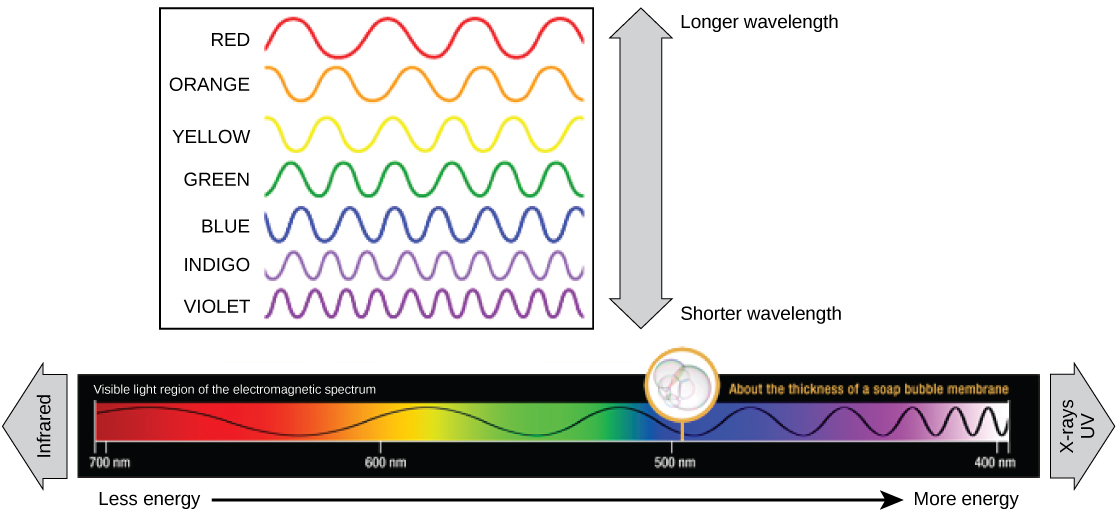
Figure 10. The colors of visible light do not carry the same amount of energy. Violet has the shortest wavelength and therefore carries the most energy, whereas red has the longest wavelength and carries the least amount of energy. (credit: modification of work by NASA)
Understanding Pigments
Different kinds of pigments exist, and each has evolved to absorb only certain wavelengths (colors) of visible light. Pigments reflect or transmit the wavelengths they cannot absorb, making them appear in the corresponding color.
Chlorophylls and carotenoids are the two major classes of photosynthetic pigments found in plants and algae; each class has multiple types of pigment molecules. There are five major chlorophylls: a , b , c and d and a related molecule found in prokaryotes called bacteriochlorophyll. Chlorophyll a and chlorophyll b are found in higher plant chloroplasts and will be the focus of the following discussion.
With dozens of different forms, carotenoids are a much larger group of pigments. The carotenoids found in fruit—such as the red of tomato (lycopene), the yellow of corn seeds (zeaxanthin), or the orange of an orange peel (β-carotene)—are used as advertisements to attract seed dispersers. In photosynthesis, carotenoids function as photosynthetic pigments that are very efficient molecules for the disposal of excess energy. When a leaf is exposed to full sun, the light-dependent reactions are required to process an enormous amount of energy; if that energy is not handled properly, it can do significant damage. Therefore, many carotenoids reside in the thylakoid membrane, absorb excess energy, and safely dissipate that energy as heat.
Each type of pigment can be identified by the specific pattern of wavelengths it absorbs from visible light, which is the absorption spectrum . The graph in Figure 11 shows the absorption spectra for chlorophyll a , chlorophyll b , and a type of carotenoid pigment called β-carotene (which absorbs blue and green light). Notice how each pigment has a distinct set of peaks and troughs, revealing a highly specific pattern of absorption. Chlorophyll a absorbs wavelengths from either end of the visible spectrum (blue and red), but not green. Because green is reflected or transmitted, chlorophyll appears green. Carotenoids absorb in the short-wavelength blue region, and reflect the longer yellow, red, and orange wavelengths.
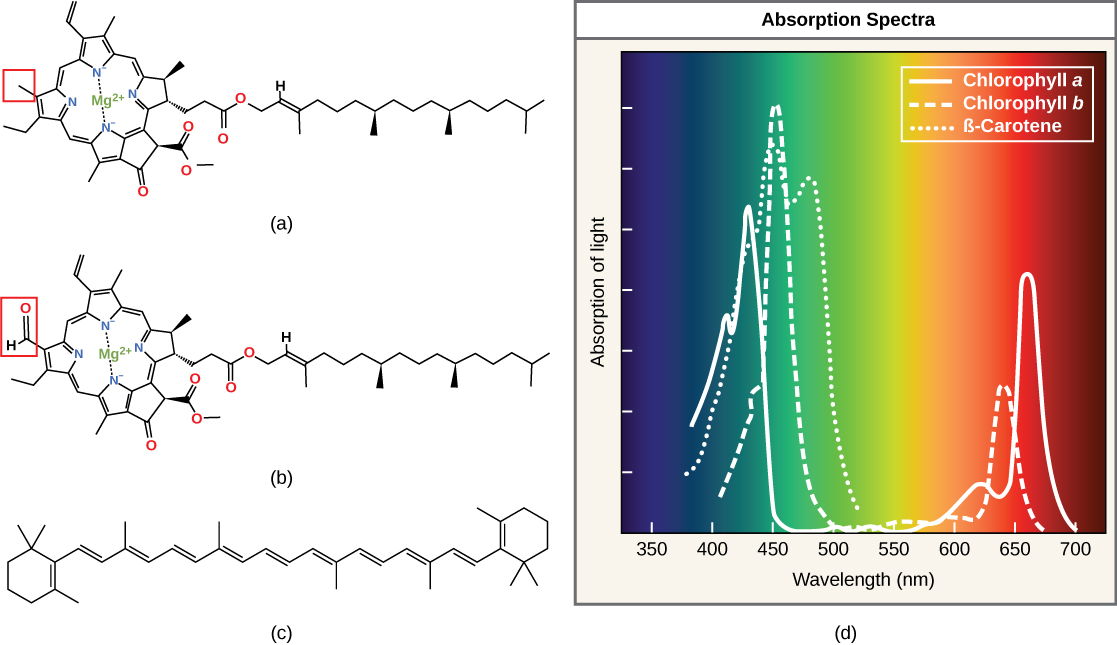
Figure 11. (a) Chlorophyll a, (b) chlorophyll b, and (c) β-carotene are hydrophobic organic pigments found in the thylakoid membrane. Chlorophyll a and b, which are identical except for the part indicated in the red box, are responsible for the green color of leaves. β-carotene is responsible for the orange color in carrots. Each pigment has (d) a unique absorbance spectrum.
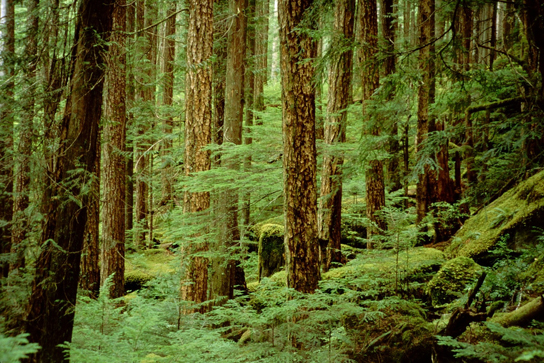
Figure 12. Plants that commonly grow in the shade have adapted to low levels of light by changing the relative concentrations of their chlorophyll pigments. (credit: Jason Hollinger)
Many photosynthetic organisms have a mixture of pigments; using them, the organism can absorb energy from a wider range of wavelengths. Not all photosynthetic organisms have full access to sunlight. Some organisms grow underwater where light intensity and quality decrease and change with depth. Other organisms grow in competition for light. Plants on the rainforest floor must be able to absorb any bit of light that comes through, because the taller trees absorb most of the sunlight and scatter the remaining solar radiation (Figure 12).
When studying a photosynthetic organism, scientists can determine the types of pigments present by generating absorption spectra. An instrument called a spectrophotometer can differentiate which wavelengths of light a substance can absorb. Spectrophotometers measure transmitted light and compute from it the absorption. By extracting pigments from leaves and placing these samples into a spectrophotometer, scientists can identify which wavelengths of light an organism can absorb. Additional methods for the identification of plant pigments include various types of chromatography that separate the pigments by their relative affinities to solid and mobile phases.
Light-Dependent Reactions
The overall function of light-dependent reactions is to convert solar energy into chemical energy in the form of NADPH and ATP. This chemical energy supports the light-independent reactions and fuels the assembly of sugar molecules. The light-dependent reactions are depicted in Figure 13. Protein complexes and pigment molecules work together to produce NADPH and ATP.
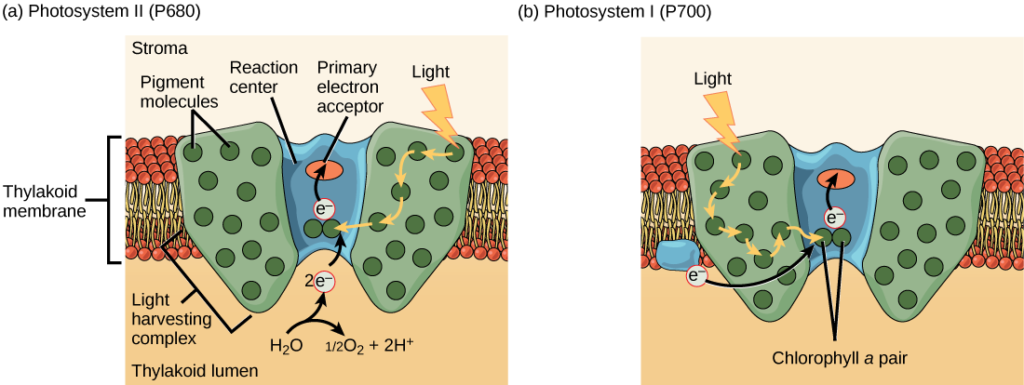
Figure 13. A photosystem consists of a light-harvesting complex and a reaction center. Pigments in the light-harvesting complex pass light energy to two special chlorophyll a molecules in the reaction center. The light excites an electron from the chlorophyll a pair, which passes to the primary electron acceptor. The excited electron must then be replaced. In (a) photosystem II, the electron comes from the splitting of water, which releases oxygen as a waste product. In (b) photosystem I, the electron comes from the chloroplast electron transport chain discussed below.
The actual step that converts light energy into chemical energy takes place in a multiprotein complex called a photosystem , two types of which are found embedded in the thylakoid membrane, photosystem II (PSII) and photosystem I (PSI) (Figure 14). The two complexes differ on the basis of what they oxidize (that is, the source of the low-energy electron supply) and what they reduce (the place to which they deliver their energized electrons).
Both photosystems have the same basic structure; a number of antenna proteins to which the chlorophyll molecules are bound surround the reaction center where the photochemistry takes place. Each photosystem is serviced by the light-harvesting complex, which passes energy from sunlight to the reaction center; it consists of multiple antenna proteins that contain a mixture of 300–400 chlorophyll a and b molecules as well as other pigments like carotenoids. The absorption of a single photon or distinct quantity or “packet” of light by any of the chlorophylls pushes that molecule into an excited state. In short, the light energy has now been captured by biological molecules but is not stored in any useful form yet. The energy is transferred from chlorophyll to chlorophyll until eventually (after about a millionth of a second), it is delivered to the reaction center. Up to this point, only energy has been transferred between molecules, not electrons.
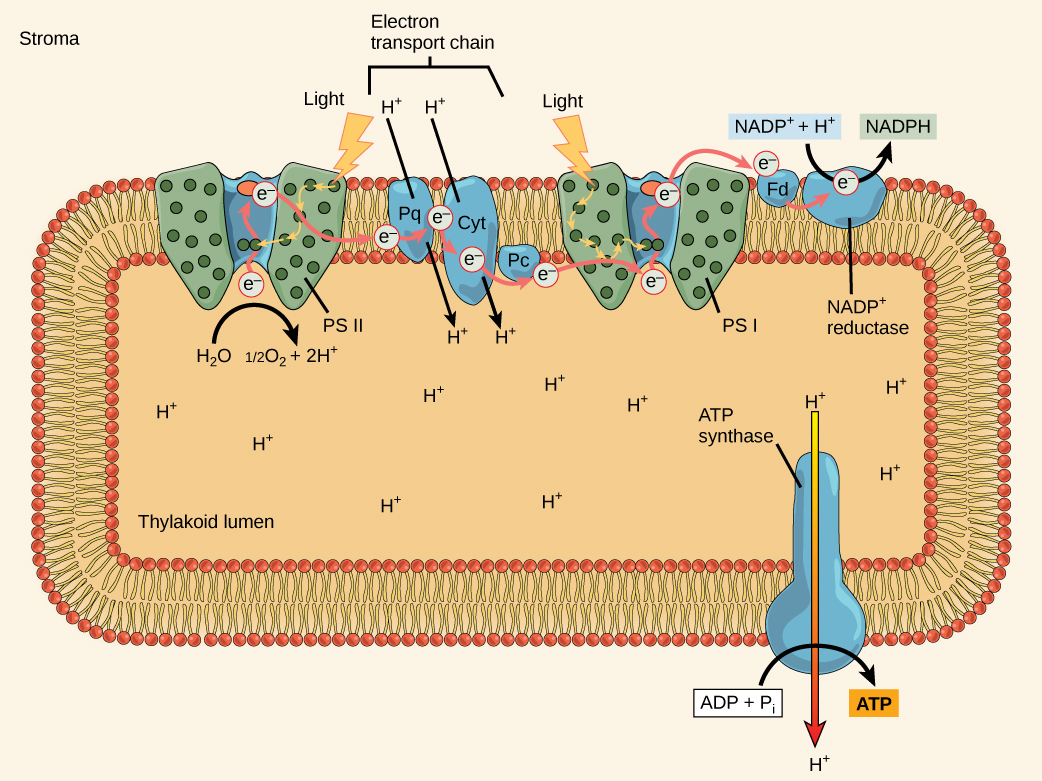
Figure 14. The photosystem II (PSII) reaction center and the photosystem I (PSI).
In the photosystem II (PSII) reaction center, energy from sunlight is used to extract electrons from water. The electrons travel through the chloroplast electron transport chain to photosystem I (PSI), which reduces NADP + to NADPH. The electron transport chain moves protons across the thylakoid membrane into the lumen. At the same time, splitting of water adds protons to the lumen, and reduction of NADPH removes protons from the stroma. The net result is a low pH in the thylakoid lumen, and a high pH in the stroma. ATP synthase uses this electrochemical gradient to make ATP. What is the initial source of electrons for the chloroplast electron transport chain?
- carbon dioxide
The reaction center contains a pair of chlorophyll a molecules with a special property. Those two chlorophylls can undergo oxidation upon excitation; they can actually give up an electron in a process called a photoact . It is at this step in the reaction center, that light energy is converted into an excited electron. All of the subsequent steps involve getting that electron onto the energy carrier NADPH for delivery to the Calvin cycle where the electron is deposited onto carbon for long-term storage in the form of a carbohydrate. PSII and PSI are two major components of the photosynthetic electron transport chain , which also includes the cytochrome complex . The cytochrome complex, an enzyme composed of two protein complexes, transfers the electrons from the carrier molecule plastoquinone (Pq) to the protein plastocyanin (Pc), thus enabling both the transfer of protons across the thylakoid membrane and the transfer of electrons from PSII to PSI.
The reaction center of PSII (called P680 ) delivers its high-energy electrons, one at the time, to the primary electron acceptor , and through the electron transport chain (Pq to cytochrome complex to plastocyanine) to PSI. P680’s missing electron is replaced by extracting a low-energy electron from water; thus, water is split and PSII is re-reduced after every photoact. Splitting one H 2 O molecule releases two electrons, two hydrogen atoms, and one atom of oxygen. Splitting two molecules is required to form one molecule of diatomic O 2 gas. About 10 percent of the oxygen is used by mitochondria in the leaf to support oxidative phosphorylation. The remainder escapes to the atmosphere where it is used by aerobic organisms to support respiration.
As electrons move through the proteins that reside between PSII and PSI, they lose energy. That energy is used to move hydrogen atoms from the stromal side of the membrane to the thylakoid lumen. Those hydrogen atoms, plus the ones produced by splitting water, accumulate in the thylakoid lumen and will be used synthesize ATP in a later step. Because the electrons have lost energy prior to their arrival at PSI, they must be re-energized by PSI, hence, another photon is absorbed by the PSI antenna. That energy is relayed to the PSI reaction center (called P700 ). P700 is oxidized and sends a high-energy electron to NADP + to form NADPH. Thus, PSII captures the energy to create proton gradients to make ATP, and PSI captures the energy to reduce NADP + into NADPH. The two photosystems work in concert, in part, to guarantee that the production of NADPH will roughly equal the production of ATP. Other mechanisms exist to fine tune that ratio to exactly match the chloroplast’s constantly changing energy needs.
Generating an Energy Carrier: ATP
As in the intermembrane space of the mitochondria during cellular respiration, the buildup of hydrogen ions inside the thylakoid lumen creates a concentration gradient. The passive diffusion of hydrogen ions from high concentration (in the thylakoid lumen) to low concentration (in the stroma) is harnessed to create ATP, just as in the electron transport chain of cellular respiration. The ions build up energy because of diffusion and because they all have the same electrical charge, repelling each other.
To release this energy, hydrogen ions will rush through any opening, similar to water jetting through a hole in a dam. In the thylakoid, that opening is a passage through a specialized protein channel called the ATP synthase. The energy released by the hydrogen ion stream allows ATP synthase to attach a third phosphate group to ADP, which forms a molecule of ATP (Figure 14). The flow of hydrogen ions through ATP synthase is called chemiosmosis because the ions move from an area of high to an area of low concentration through a semi-permeable structure.
Light-Independent Reactions
After the energy from the sun is converted into chemical energy and temporarily stored in ATP and NADPH molecules, the cell has the fuel needed to build carbohydrate molecules for long-term energy storage. The products of the light-dependent reactions, ATP and NADPH, have lifespans in the range of millionths of seconds, whereas the products of the light-independent reactions (carbohydrates and other forms of reduced carbon) can survive for hundreds of millions of years. The carbohydrate molecules made will have a backbone of carbon atoms. Where does the carbon come from? It comes from carbon dioxide, the gas that is a waste product of respiration in microbes, fungi, plants, and animals.
In plants, carbon dioxide (CO 2 ) enters the leaves through stomata, where it diffuses over short distances through intercellular spaces until it reaches the mesophyll cells. Once in the mesophyll cells, CO 2 diffuses into the stroma of the chloroplast—the site of light-independent reactions of photosynthesis. These reactions actually have several names associated with them. Another term, the Calvin cycle , is named for the man who discovered it, and because these reactions function as a cycle. Others call it the Calvin-Benson cycle to include the name of another scientist involved in its discovery. The most outdated name is dark reactions, because light is not directly required (Figure 15). However, the term dark reaction can be misleading because it implies incorrectly that the reaction only occurs at night or is independent of light, which is why most scientists and instructors no longer use it.
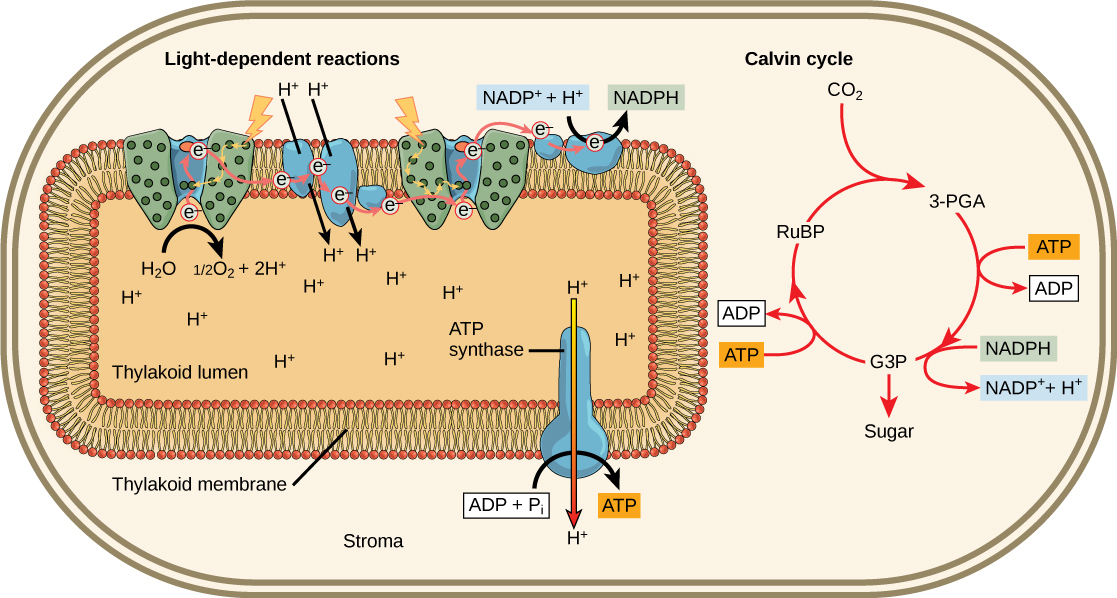
Figure 15. Light reactions harness energy from the sun to produce chemical bonds, ATP, and NADPH. These energy-carrying molecules are made in the stroma where carbon fixation takes place.
The light-independent reactions of the Calvin cycle can be organized into three basic stages: fixation, reduction, and regeneration.
Stage 1: Fixation
In the stroma, in addition to CO 2 , two other components are present to initiate the light-independent reactions: an enzyme called ribulose bisphosphate carboxylase (RuBisCO), and three molecules of ribulose bisphosphate (RuBP), as shown in Figure 16. RuBP has five atoms of carbon, flanked by two phosphates.
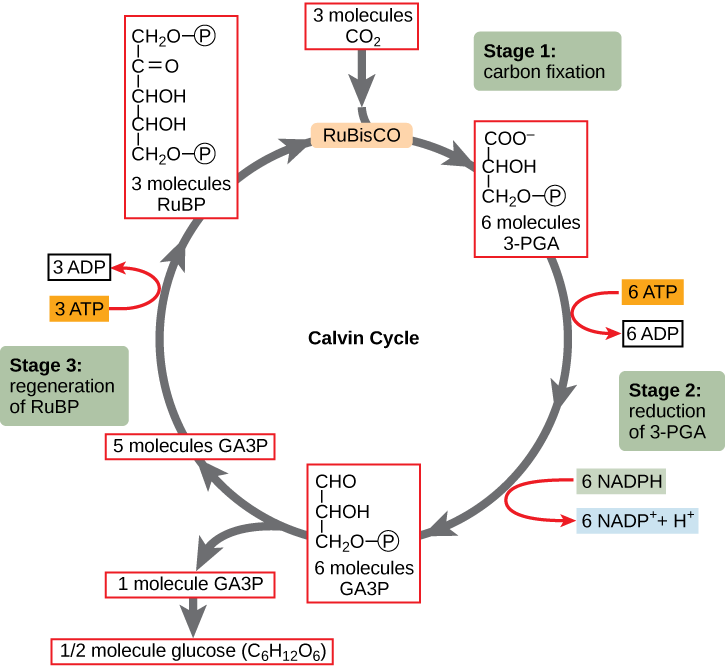
Figure 16. The Calvin cycle has three stages.
In stage 1, the enzyme RuBisCO incorporates carbon dioxide into an organic molecule, 3-PGA. In stage 2, the organic molecule is reduced using electrons supplied by NADPH. In stage 3, RuBP, the molecule that starts the cycle, is regenerated so that the cycle can continue. Only one carbon dioxide molecule is incorporated at a time, so the cycle must be completed three times to produce a single three-carbon GA3P molecule, and six times to produce a six-carbon glucose molecule.
Which of the following statements is true?
- In photosynthesis, oxygen, carbon dioxide, ATP, and NADPH are reactants. GA3P and water are products.
- In photosynthesis, chlorophyll, water, and carbon dioxide are reactants. GA3P and oxygen are products.
- In photosynthesis, water, carbon dioxide, ATP, and NADPH are reactants. RuBP and oxygen are products.
- In photosynthesis, water and carbon dioxide are reactants. GA3P and oxygen are products.
RuBisCO catalyzes a reaction between CO 2 and RuBP. For each CO 2 molecule that reacts with one RuBP, two molecules of another compound (3-PGA) form. PGA has three carbons and one phosphate. Each turn of the cycle involves only one RuBP and one carbon dioxide and forms two molecules of 3-PGA. The number of carbon atoms remains the same, as the atoms move to form new bonds during the reactions (3 atoms from 3CO 2 + 15 atoms from 3RuBP = 18 atoms in 3 atoms of 3-PGA). This process is called carbon fixation , because CO 2 is “fixed” from an inorganic form into organic molecules.
Stage 2: Reduction
ATP and NADPH are used to convert the six molecules of 3-PGA into six molecules of a chemical called glyceraldehyde 3-phosphate (G3P). That is a reduction reaction because it involves the gain of electrons by 3-PGA. Recall that a reduction is the gain of an electron by an atom or molecule. Six molecules of both ATP and NADPH are used. For ATP, energy is released with the loss of the terminal phosphate atom, converting it into ADP; for NADPH, both energy and a hydrogen atom are lost, converting it into NADP + . Both of these molecules return to the nearby light-dependent reactions to be reused and reenergized.
Stage 3: Regeneration
Interestingly, at this point, only one of the G3P molecules leaves the Calvin cycle and is sent to the cytoplasm to contribute to the formation of other compounds needed by the plant. Because the G3P exported from the chloroplast has three carbon atoms, it takes three “turns” of the Calvin cycle to fix enough net carbon to export one G3P. But each turn makes two G3Ps, thus three turns make six G3Ps. One is exported while the remaining five G3P molecules remain in the cycle and are used to regenerate RuBP, which enables the system to prepare for more CO 2 to be fixed. Three more molecules of ATP are used in these regeneration reactions.
Evolution of Photosynthesis
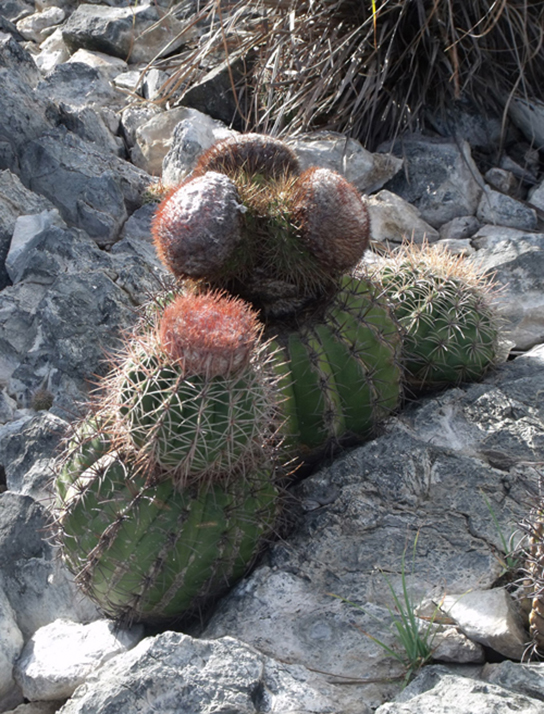
Figure 17. The harsh conditions of the desert have led plants like these cacti to evolve variations of the light-independent reactions of photosynthesis. These variations increase the efficiency of water usage, helping to conserve water and energy. (credit: Piotr Wojtkowski)
During the evolution of photosynthesis, a major shift occurred from the bacterial type of photosynthesis that involves only one photosystem and is typically anoxygenic (does not generate oxygen) into modern oxygenic (does generate oxygen) photosynthesis, employing two photosystems. This modern oxygenic photosynthesis is used by many organisms—from giant tropical leaves in the rainforest to tiny cyanobacterial cells—and the process and components of this photosynthesis remain largely the same. Photosystems absorb light and use electron transport chains to convert energy into the chemical energy of ATP and NADH. The subsequent light-independent reactions then assemble carbohydrate molecules with this energy.
Photosynthesis in desert plants has evolved adaptations that conserve water. In the harsh dry heat, every drop of water must be used to survive. Because stomata must open to allow for the uptake of CO 2 , water escapes from the leaf during active photosynthesis. Desert plants have evolved processes to conserve water and deal with harsh conditions. A more efficient use of CO 2 allows plants to adapt to living with less water. Some plants such as cacti (Figure 17) can prepare materials for photosynthesis during the night by a temporary carbon fixation/storage process, because opening the stomata at this time conserves water due to cooler temperatures. In addition, cacti have evolved the ability to carry out low levels of photosynthesis without opening stomata at all, a mechanism to face extremely dry periods.
Now that we’ve learned about the different pieces of photosynthesis, let’s put it all together. This video walks you through the process of photosynthesis as a whole:
In Summary: An Overview of Photosynthesis
The process of photosynthesis transformed life on Earth. By harnessing energy from the sun, photosynthesis evolved to allow living things access to enormous amounts of energy. Because of photosynthesis, living things gained access to sufficient energy that allowed them to build new structures and achieve the biodiversity evident today.
Only certain organisms, called photoautotrophs, can perform photosynthesis; they require the presence of chlorophyll, a specialized pigment that absorbs certain portions of the visible spectrum and can capture energy from sunlight. Photosynthesis uses carbon dioxide and water to assemble carbohydrate molecules and release oxygen as a waste product into the atmosphere. Eukaryotic autotrophs, such as plants and algae, have organelles called chloroplasts in which photosynthesis takes place, and starch accumulates. In prokaryotes, such as cyanobacteria, the process is less localized and occurs within folded membranes, extensions of the plasma membrane, and in the cytoplasm.
The pigments of the first part of photosynthesis, the light-dependent reactions, absorb energy from sunlight. A photon strikes the antenna pigments of photosystem II to initiate photosynthesis. The energy travels to the reaction center that contains chlorophyll a to the electron transport chain, which pumps hydrogen ions into the thylakoid interior. This action builds up a high concentration of ions. The ions flow through ATP synthase via chemiosmosis to form molecules of ATP, which are used for the formation of sugar molecules in the second stage of photosynthesis. Photosystem I absorbs a second photon, which results in the formation of an NADPH molecule, another energy and reducing power carrier for the light-independent reactions.
Check Your Understanding
Answer the question(s) below to see how well you understand the topics covered in the previous section. This short quiz does not count toward your grade in the class, and you can retake it an unlimited number of times.
Use this quiz to check your understanding and decide whether to (1) study the previous section further or (2) move on to the next section.
- Authored by : Shelli Carter and Lumen Learning. Provided by : Lumen Learning. License : CC BY: Attribution
- Biology. Provided by : OpenStax CNX. Located at : http://cnx.org/contents/[email protected] . License : CC BY: Attribution . License Terms : Download for free at http://cnx.org/contents/[email protected]
- Photosynthesis: Crash Course Biology #8. Authored by : CrashCourse. Located at : https://youtu.be/sQK3Yr4Sc_k . License : All Rights Reserved . License Terms : Standard YouTube License
10 Fascinating Photosynthesis Facts
- Biochemistry
- Chemical Laws
- Periodic Table
- Projects & Experiments
- Scientific Method
- Physical Chemistry
- Medical Chemistry
- Chemistry In Everyday Life
- Famous Chemists
- Activities for Kids
- Abbreviations & Acronyms
- Weather & Climate
- Ph.D., Biomedical Sciences, University of Tennessee at Knoxville
- B.A., Physics and Mathematics, Hastings College
Photosynthesis is the name given to the set of biochemical reactions that change carbon dioxide and water into the sugar glucose and oxygen. Read on to learn more about this fascinating and essential concept.
Glucose isn't just food.
While the sugar glucose is used for energy, it has other purposes, too. For example, plants use glucose as a building block to build starch for long-term energy storage and cellulose to build structures.
Leaves are green because of chlorophyll.
The most common molecule used for photosynthesis is chlorophyll . Plants are green because their cells contain an abundance of chlorophyll. Chlorophyll absorbs the solar energy that drives the reaction between carbon dioxide and water. The pigment appears green because it absorbs blue and red wavelengths of light, reflecting green.
Chlorophyll isn't the only photosynthetic pigment.
Chlorophyll is not a single pigment molecule, but rather is a family of related molecules that share a similar structure. There are other pigment molecules that absorb/reflect different wavelengths of light.
Plants appear green because their most abundant pigment is chlorophyll, but you can sometimes see the other molecules. In the autumn, leaves produce less chlorophyll in preparation for winter. As chlorophyll production slows, leaves change color . You can see the red, purple, and gold colors of other photosynthetic pigments. Algae commonly display the others colors, too.
Plants perform photosynthesis in organelles called chloroplasts.
Eukaryotic cells , like those in plants, contain specialized membrane-enclosed structures called organelles. Chloroplasts and mitochondria are two examples of organelles . Both organelles are involved in energy production.
Mitochondria perform aerobic cellular respiration, which uses oxygen to make adenosine triphosphate (ATP). Breaking one or more phosphate groups off of the molecule releases energy in a form plant and animal cells can use.
Chloroplasts contain chlorophyll, which is used in photosynthesis to make glucose. A chloroplast contains structures called grana and stroma. Grana resemble a stack of pancakes. Collectively, grana form a structure called a thylakoid . The grana and thylakoid are where light-dependent chemical reactions occur (those involving chlorophyll). The fluid around the grana is called the stroma. This is where light-independent reactions occur. Light independent reactions sometimes are called "dark reactions," but this just means light isn't required. The reactions can occur in the presence of light.
The magic number is six.
Glucose is a simple sugar, yet it is a large molecule compared to carbon dioxide or water. It takes six molecules of carbon dioxide and six molecules of water to make one molecule of glucose and six molecules of oxygen. The balanced chemical equation for the overall reaction is:
6CO 2 (g) + 6H 2 O(l) → C 6 H 12 O 6 + 6O 2 (g)
Photosynthesis is the reverse of cellular respiration.
Both photosynthesis and cellular respiration yield molecules used for energy. However, photosynthesis produces the sugar glucose, which is an energy storage molecule. Cellular respiration takes the sugar and turns it into a form both plants and animals can use.
Photosynthesis requires carbon dioxide and water to make sugar and oxygen. Cellular respiration uses oxygen and sugar to release energy, carbon dioxide, and water.
Plants and other photosynthetic organisms perform both sets of reactions. In the daytime, most plants take carbon dioxide and release oxygen. During the day and at night, plants use oxygen to release the energy from sugar, and release carbon dioxide. In plants, these reactions aren't equal. Green plants release much more oxygen than they use. In fact, they are responsible for the Earth's breathable atmosphere.
Plants aren't the only organisms that perform photosynthesis.
Organisms that use light for the energy needed to make their own food are called producers . In contrast, consumers are creatures that eat producers to get energy. While plants are the best-known producers, algae, cyanobacteria, and some protists also make sugar via photosynthesis.
Most people know algae and some single-celled organisms are photosynthetic, but did you know some multicellular animals are , too? Some consumers perform photosynthesis as a secondary energy source. For example, a species of sea slug ( Elysia chlorotica ) steals photosynthetic organelles chloroplasts from algae and places them into its own cells. The spotted salamander ( Ambystoma maculatum ) has a symbiotic relationship with algae, using the extra oxygen to supply mitochondria. The oriental hornet (Vespa orientalis) uses the pigment xanthoperin to convert light into electricity, which it uses as a sort of solar cell to power nighttime activity.
There is more than one form of photosynthesis.
The overall reaction describes the input and output of photosynthesis, but plants use different sets of reactions to achieve this outcome. All plants use two general pathways: lights reactions and dark reactions ( Calvin cycle ).
"Normal" or C 3 photosynthesis occurs when plants have lots of available water. This set of reactions uses the enzyme RuBP carboxylase to react with carbon dioxide. The process is highly efficient because both the light and dark reactions can occur simultaneously in a plant cell.
In C 4 photosynthesis, the enzyme PEP carboxylase is used instead of RuBP carboxylase. This enzyme is useful when water may be scarce, but all of the photosynthetic reactions can't take place in the same cells.
In Cassulacean-acid metabolism or CAM photosynthesis , carbon dioxide is only taken into plants at night, where it is stored in vacuoles to be processed during the day. CAM photosynthesis helps plants conserve water because leaf stomata are only open at night, when it's cooler and more humid. The disadvantage is the plant can only produce glucose from the stored carbon dioxide. Because less glucose is produced, desert plants using CAM photosynthesis tend to grow very slowly.
Plants are built for photosynthesis.
Plants are wizards as far as photosynthesis is concerned. Their entire structure is built to support the process. The plant's roots are designed to absorb water, which is then transported by a special vascular tissue called xylem, so it can be available in the photosynthetic stem and leaves. Leaves contain special pores called stomata that control gas exchange and limit water loss. Leaves may have a waxy coating to minimize water loss. Some plants have spines to promote water condensation.
Photosynthesis makes the planet liveable.
Most people are aware that photosynthesis releases the oxygen animals need to live, but the other important component of the reaction is carbon fixation. Photosynthetic organisms remove carbon dioxide from the air. Carbon dioxide is transformed into other organic compounds, supporting life. While animals exhale carbon dioxide, trees and algae act as a carbon sink, keeping most of the element out of the air.
Photosynthesis Key Takeaways
- Photosynthesis refers to a set of chemicals reactions in which energy from the sun changes carbon dioxide and water into glucose and oxygen.
- Sunlight is most often harnessed by chlorophyll, which is green because it reflects green light. However, there are other pigments that also work.
- Plants, algae, cyanobacteria, and some protists perform photosynthesis. A few animals are photosynthetic, too.
- Photosynthesis may be the most important chemical reaction on the planet because it releases oxygen and traps carbon.
- The Photosynthesis Formula: Turning Sunlight into Energy
- Chloroplast Function in Photosynthesis
- What Are the Products of Photosynthesis?
- Photosynthesis Vocabulary Terms and Definitions
- Photosynthesis Basics - Study Guide
- All About Photosynthetic Organisms
- Thylakoid Definition and Function
- Chlorophyll Definition and Role in Photosynthesis
- Calvin Cycle Steps and Diagram
- Examples of Chemical Reactions in Everyday Life
- Plant Leaves and Leaf Anatomy
- What Is the Primary Function of the Calvin Cycle?
- The Balanced Chemical Equation for Photosynthesis
- Adaptations to Climate Change in C3, C4, and CAM Plants
- Glucose Molecular Formula and Facts
- Learn About Diffusion
Understanding Global Change
Discover why the climate and environment changes, your place in the Earth system, and paths to a resilient future.
Photosynthesis

Photosynthesis is the processes of using sunlight to convert chemical compounds (specifically carbon dioxide and water ) into food . Photosynthesizing organisms (plants, algae, and bacteria) provide most of the chemical energy that flows through the biosphere. They also produced most of the biomass that led to the fossil fuels that power much of our modern world. Photosynthesis takes place on land, in the ocean, and in freshwater environments. The first photosynthesizing single-celled bacteria evolved over 3.5 billion years ago. The subsequent rise in atmospheric oxygen (a byproduct of photosynthesis) about a billion years later played a major role in shaping the evolution of life on Earth over the last 2.5 billion years. Today the vast majority of land, freshwater, and oceanic organisms require oxygen for respiration , the biochemical process that generates energy from food.
On this page:
What is photosynthesis, earth system model about photosynthesis, explore the earth system, investigate, links to learn more.
For the classroom:
- Teaching Resources

Global Change Infographic
Photosynthesus is an essential part of How the Earth System Works. Click the image on the left to open the Understanding Global Change Infographic . Locate the photosynthesis icon and identify other Earth system processes and phenomena that cause changes to, or are affected by, photosynthesis.
Photosynthesis is the chemical process by which plants, algae, and some bacteria use the energy from sunlight to transform carbon dioxide (a greenhouse gas ) from the atmosphere, and water , into organic compounds such as sugars. These sugars are then used to make complex carbohydrates, lipids, and proteins, as well as the wood, leaves, and roots of plants. The amount of organic matter made by photosynthesizing organisms in an ecosystem is defined as the productivity of that ecosystem. Energy flows through the biosphere as organisms (including some animals) eat photosynthesizing organisms (called herbivores), and as organisms then eat those herbivores (carnivores) , etc., to get their energy for growth, reproduction, and other functions. This energy is acquired through the process of cellular respiration , which usually requires oxygen. Oxygen is a byproduct of photosynthesis. About 70% of the oxygen in the atmosphere that we breathe comes from algae in the ocean. Atmospheric oxygen from photosynthesis also forms the ozone layer , which protects organisms from harmful high-energy ultraviolet (UV) radiation from the Sun . Because photosynthesis also requires water , the availability of water affects the productivity and biomass of the ecosystem, which in turn affects how much and how rapidly water cycles through the ecosystem.
Fossil fuels are derived from the burial of photosynthetic organisms, including plants on land (which primarily form coal) and plankton in the oceans (which primarily form oil and natural gas). While buried, the carbon in the organic material is removed from the carbon cycle for thousands of years to hundreds of millions of years. The burning of fossil fuels has dramatically increased the exchange of carbon from the ground back into the atmosphere and oceans. This return of carbon back into atmosphere as carbon dioxide is occurring at a rate that is hundreds to thousands of times faster than it took to bury it, and much faster than it can be removed by photosynthesis or weathering . Thus, the carbon dioxide released from the burning of fossil fuels is accumulating in the atmosphere, increasing average temperatures and causing ocean acidification .
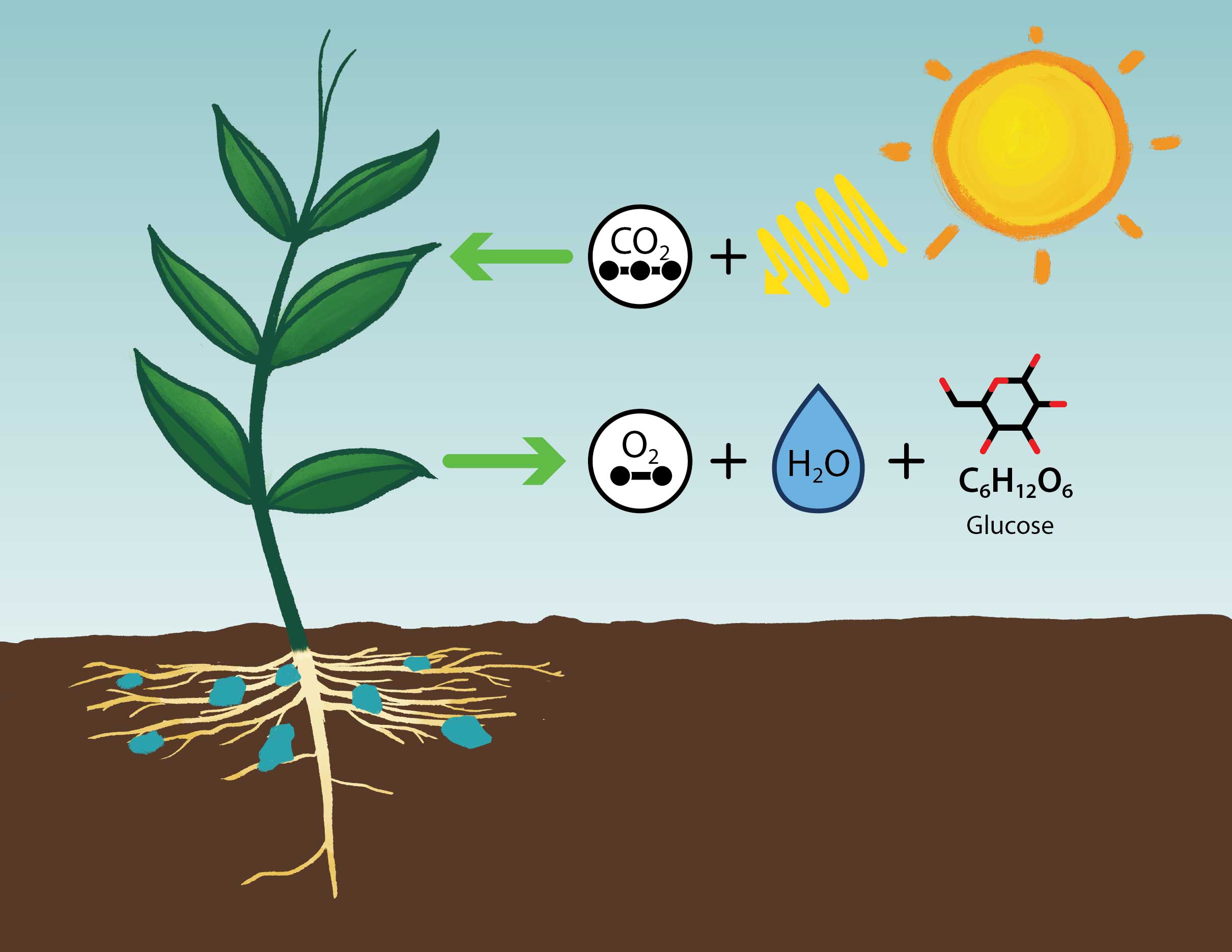
A simplified diagram showing the overall inputs – carbon dioxide, water, and sunlight, and products – oxygen and sugar (glucose), of photosynthesis.
The rate of photosynthesis in ecosystems is affected by various environmental conditions, including:
- Climatic conditions, such as the amount of sunlight available at different latitudes , temperature , and precipitation For example, ecosystems at low latitudes, such as tropical rainforests, have higher productivity and biomass than ecosystems near the poles because of they receive more sunlight and rainfall than regions at higher latitudes.
- Nutrients , especially nitrogen and phosphorus , which when limited can decrease productivity, but when abundant can increase productivity and biomass. Photosynthesizing organisms extract nutrients from the environment, and return them to the soil when they die and decay.
- Numerous other abiotic environmental factors, including soil quality (often related to nutrient levels), wildfires , water acidity , and oxygen levels .
- Species interactions , including the resources species provide for each other, and how they compete for resources such as water, light, and/or space. Species that reduce or increase the success of other species alter population sizes , thus affecting productivity and biomass .
- Evolutionary processes that can change the growth and reproduction rates of photosynthesizing organisms over time, as well as the growth and reproduction of rates of the organisms that eat them.
Humans have altered the rate of photosynthesis, and in turn productivity , in ecosystems through a variety of activities, including:
- Deforestation , habitat destruction , and urbanization , which remove plants and trees from the environment and disrupt ecosystems.
- Agricultural activities that increase the amount of crops available to feed the growing global human population .
- The use of fertilizers for agricultural activities that increase the amount of nutrients , especially nitrogen and phosphorous , in soil or water. These nutrients increase plant and algae growth, including growth of species that are toxic to other organisms. Increased nutrients is not always a good thing. For example, in aquatic environments, nutrient-rich runoff can cause large amounts of algae to grow – when these algae die, they are consumed by bacteria which can reduce oxygen levels in the water, killing fish and other species. This process is known as eutrophication.
- Human freshwater use , which can limit the amount of water available for plants and trees in an ecosystem.
- The release of pollutants and waste , which can reduce growth and reproduction or kill plants.
- Activities that release carbon dioxide and other greenhouse gases that cause global warming, such as the burning of fossil fuels , agricultural activities , and deforestation . Increasing carbon dioxide levels may increase photosynthesis rates in some plants, but this can also make plants less nutritious . Increasing average global land and ocean temperatures and changes in precipitation patterns also affect plant and algae growth, and can make certain species more susceptible to disease .
- Activities such as the burning of fossil fuels , agricultural activities , and deforestation that release carbon dioxide into the atmosphere, which is absorbed by the ocean causing acidification . The decreasing pH of ocean waters (along with ocean warming) causes physiological stress for many plant and algae species, which can decrease growth, reproduction, species population sizes, and biomass .
- The increase in carbon dioxide to the atmosphere is also thought to impact global photosynthesis rates. During photosynthesis, plants convert carbon dioxide to biomass such as sugars and wood. However, the same enzyme (rubisco) that fixes carbon dioxide can also use oxygen. When oxygen is used, plants undergo a process known as photorespiration where biomass is not produced and instead carbon dioxide is emitted to the atmosphere (see this teaching resource for more information). Photorespiration is often considered a negative process for plants. It has been proposed that as carbon dioxide levels rise in the atmosphere rates of photorespiration will decrease and rates of photosynthesis will increase. This change is termed carbon dioxide fertilization and demonstrates the complex interactions between life and climate change.
- Introducing invasive species that compete with native plant or algae species for nutrients, water, light, or other resources, reducing native species populations.
The Earth system model below includes some of the processes and phenomena related to photosynthesis. These processes operate at various rates and on different spatial and temporal scales. For example, carbon dioxide is transferred among plants and animals over relatively short time periods (hours-weeks), but the deforestation alters ecosystems over decades to centuries, or longer. Can you think of additional cause and effect relationships between photosynthesis and other processes in the Earth system?
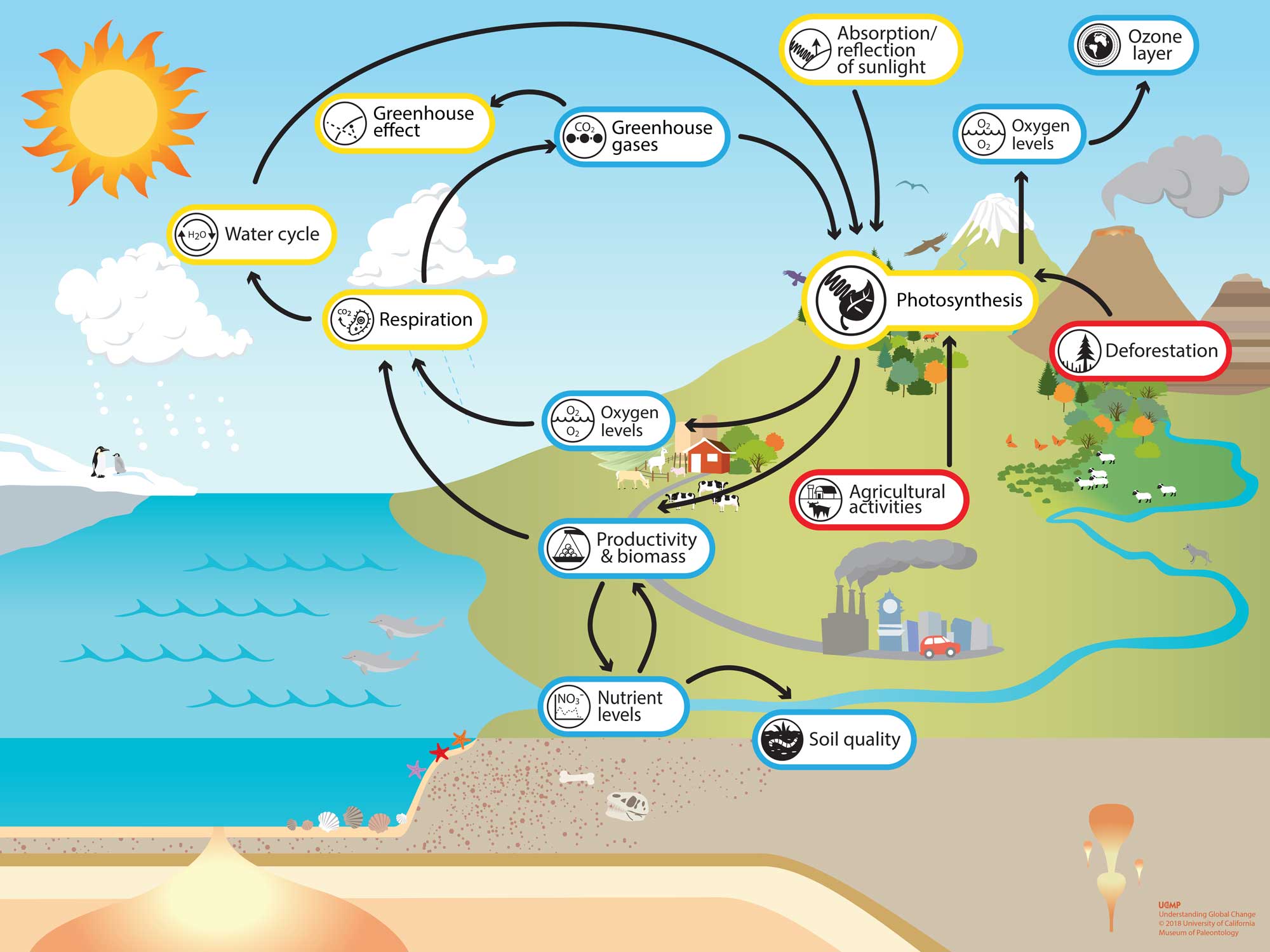
Click the bolded terms (e.g. respiration , productivity and biomass , and burning of fossil fuels ) on this page to learn more about these process and phenomena. Alternatively, explore the Understanding Global Change Infographic and find new topics that are of interest and/or locally relevant to you.
Learn more in these real-world examples, and challenge yourself to construct a model that explains the Earth system relationships.
- The bacteria that changed the world
- New York Times: Antarctic Ice Reveals Earth’s Accelerating Plant Growth
- USGCRP: Climate and Health Assessment, Food Safety, Nutrition, and Distribution
- HHMI BioInteractive: Photosynthesis
- Evolution Connection: More on photorespiration

- school Campus Bookshelves
- menu_book Bookshelves
- perm_media Learning Objects
- login Login
- how_to_reg Request Instructor Account
- hub Instructor Commons
Margin Size
- Download Page (PDF)
- Download Full Book (PDF)
- Periodic Table
- Physics Constants
- Scientific Calculator
- Reference & Cite
- Tools expand_more
- Readability
selected template will load here
This action is not available.

6.6: Photosynthesis
- Last updated
- Save as PDF
- Page ID 35693
\( \newcommand{\vecs}[1]{\overset { \scriptstyle \rightharpoonup} {\mathbf{#1}} } \)
\( \newcommand{\vecd}[1]{\overset{-\!-\!\rightharpoonup}{\vphantom{a}\smash {#1}}} \)
\( \newcommand{\id}{\mathrm{id}}\) \( \newcommand{\Span}{\mathrm{span}}\)
( \newcommand{\kernel}{\mathrm{null}\,}\) \( \newcommand{\range}{\mathrm{range}\,}\)
\( \newcommand{\RealPart}{\mathrm{Re}}\) \( \newcommand{\ImaginaryPart}{\mathrm{Im}}\)
\( \newcommand{\Argument}{\mathrm{Arg}}\) \( \newcommand{\norm}[1]{\| #1 \|}\)
\( \newcommand{\inner}[2]{\langle #1, #2 \rangle}\)
\( \newcommand{\Span}{\mathrm{span}}\)
\( \newcommand{\id}{\mathrm{id}}\)
\( \newcommand{\kernel}{\mathrm{null}\,}\)
\( \newcommand{\range}{\mathrm{range}\,}\)
\( \newcommand{\RealPart}{\mathrm{Re}}\)
\( \newcommand{\ImaginaryPart}{\mathrm{Im}}\)
\( \newcommand{\Argument}{\mathrm{Arg}}\)
\( \newcommand{\norm}[1]{\| #1 \|}\)
\( \newcommand{\Span}{\mathrm{span}}\) \( \newcommand{\AA}{\unicode[.8,0]{x212B}}\)
\( \newcommand{\vectorA}[1]{\vec{#1}} % arrow\)
\( \newcommand{\vectorAt}[1]{\vec{\text{#1}}} % arrow\)
\( \newcommand{\vectorB}[1]{\overset { \scriptstyle \rightharpoonup} {\mathbf{#1}} } \)
\( \newcommand{\vectorC}[1]{\textbf{#1}} \)
\( \newcommand{\vectorD}[1]{\overrightarrow{#1}} \)
\( \newcommand{\vectorDt}[1]{\overrightarrow{\text{#1}}} \)
\( \newcommand{\vectE}[1]{\overset{-\!-\!\rightharpoonup}{\vphantom{a}\smash{\mathbf {#1}}}} \)
What you’ll learn to do: Identify the basic components and steps of photosynthesis
No matter how complex or advanced a machine, such as the latest cellular phone, the device cannot function without energy. Living things, similar to machines, have many complex components; they too cannot do anything without energy, which is why humans and all other organisms must “eat” in some form or another. That may be common knowledge, but how many people realize that every bite of every meal ingested depends on the process of photosynthesis?

Learning Objectives
- Summarize the process of photosynthesis
- Describe how the wavelength of light affects its energy and color
- Describe the light-dependent reactions that take place during photosynthesis
- Describe the steps and processes in the Calvin Cycle
An Overview of Photosynthesis
All living organisms on earth consist of one or more cells. Each cell runs on the chemical energy found mainly in carbohydrate molecules (food), and the majority of these molecules are produced by one process: photosynthesis. Through photosynthesis, certain organisms convert solar energy (sunlight) into chemical energy, which is then used to build carbohydrate molecules. The energy used to hold these molecules together is released when an organism breaks down food. Cells then use this energy to perform work, such as cellular respiration.
The energy that is harnessed from photosynthesis enters the ecosystems of our planet continuously and is transferred from one organism to another. Therefore, directly or indirectly, the process of photosynthesis provides most of the energy required by living things on earth.
Photosynthesis also results in the release of oxygen into the atmosphere. In short, to eat and breathe, humans depend almost entirely on the organisms that carry out photosynthesis.
Learn more about photosynthesis
Solar Dependence and Food Production
Some organisms can carry out photosynthesis, whereas others cannot. An autotroph is an organism that can produce its own food. The Greek roots of the word autotroph mean “self” ( auto ) “feeder” ( troph ). Plants are the best-known autotrophs, but others exist, including certain types of bacteria and algae (Figure 2). Oceanic algae contribute enormous quantities of food and oxygen to global food chains. Plants are also photoautotrophs, a type of autotroph that uses sunlight and carbon from carbon dioxide to synthesize chemical energy in the form of carbohydrates. All organisms carrying out photosynthesis require sunlight.

Heterotrophs are organisms incapable of photosynthesis that must therefore obtain energy and carbon from food by consuming other organisms. The Greek roots of the word heterotroph mean “other” ( hetero ) “feeder” ( troph ), meaning that their food comes from other organisms. Even if the food organism is another animal, this food traces its origins back to autotrophs and the process of photosynthesis. Humans are heterotrophs, as are all animals. Heterotrophs depend on autotrophs, either directly or indirectly. Deer and wolves are heterotrophs. A deer obtains energy by eating plants. A wolf eating a deer obtains energy that originally came from the plants eaten by that deer. The energy in the plant came from photosynthesis, and therefore it is the only autotroph in this example (Figure 3). Using this reasoning, all food eaten by humans also links back to autotrophs that carry out photosynthesis.
Photosynthesis is a multi-step process that requires sunlight, carbon dioxide (which is low in energy), and water as substrates (Figure 4). After the process is complete, it releases oxygen and produces glyceraldehyde-3-phosphate (GA3P), simple carbohydrate molecules (which are high in energy) that can subsequently be converted into glucose, sucrose, or any of dozens of other sugar molecules. These sugar molecules contain energy and the energized carbon that all living things need to survive.

The following is the chemical equation for photosynthesis (Figure 5):

Although the equation looks simple, the many steps that take place during photosynthesis are actually quite complex. Before learning the details of how photoautotrophs turn sunlight into food, it is important to become familiar with the structures involved.
In plants, photosynthesis generally takes place in leaves, which consist of several layers of cells. The process of photosynthesis occurs in a middle layer called the mesophyll . The gas exchange of carbon dioxide and oxygen occurs through small, regulated openings called stomata (singular: stoma), which also play roles in the regulation of gas exchange and water balance. The stomata are typically located on the underside of the leaf, which helps to minimize water loss. Each stoma is flanked by guard cells that regulate the opening and closing of the stomata by swelling or shrinking in response to osmotic changes.
In all autotrophic eukaryotes, photosynthesis takes place inside an organelle called a chloroplast . For plants, chloroplast-containing cells exist in the mesophyll. Chloroplasts have a double membrane envelope (composed of an outer membrane and an inner membrane). Within the chloroplast are stacked, disc-shaped structures called thylakoids . Embedded in the thylakoid membrane is chlorophyll, a pigment (molecule that absorbs light) responsible for the initial interaction between light and plant material, and numerous proteins that make up the electron transport chain. The thylakoid membrane encloses an internal space called the thylakoid lumen . As shown in Figure 6, a stack of thylakoids is called a granum , and the liquid-filled space surrounding the granum is called stroma or “bed” (not to be confused with stoma or “mouth,” an opening on the leaf epidermis).
Practice Question

On a hot, dry day, plants close their stomata to conserve water. What impact will this have on photosynthesis?
Levels of carbon dioxide (a necessary photosynthetic substrate) will immediately fall. As a result, the rate of photosynthesis will be inhibited.
The Two Parts of Photosynthesis
Photosynthesis takes place in two sequential stages: the light-dependent reactions and the light independent-reactions. In the light-dependent reactions , energy from sunlight is absorbed by chlorophyll and that energy is converted into stored chemical energy. In the light-independent reactions , the chemical energy harvested during the light-dependent reactions drive the assembly of sugar molecules from carbon dioxide. Therefore, although the light-independent reactions do not use light as a reactant, they require the products of the light-dependent reactions to function. In addition, several enzymes of the light-independent reactions are activated by light. The light-dependent reactions utilize certain molecules to temporarily store the energy: These are referred to as energy carriers. The energy carriers that move energy from light-dependent reactions to light-independent reactions can be thought of as “full” because they are rich in energy. After the energy is released, the “empty” energy carriers return to the light-dependent reaction to obtain more energy. Figure 7 illustrates the components inside the chloroplast where the light-dependent and light-independent reactions take place.

Click the link to learn more about photosynthesis.

Major grocery stores in the United States are organized into departments, such as dairy, meats, produce, bread, cereals, and so forth. Each aisle (Figure 8) contains hundreds, if not thousands, of different products for customers to buy and consume.
Although there is a large variety, each item links back to photosynthesis. Meats and dairy link because the animals were fed plant-based foods. The breads, cereals, and pastas come largely from starchy grains, which are the seeds of photosynthesis-dependent plants. What about desserts and drinks? All of these products contain sugar—sucrose is a plant product, a disaccharide, a carbohydrate molecule, which is built directly from photosynthesis. Moreover, many items are less obviously derived from plants: for instance, paper goods are generally plant products, and many plastics (abundant as products and packaging) can be derived from algae or from oil, the fossilized remains of photosynthetic organisms. Virtually every spice and flavoring in the spice aisle was produced by a plant as a leaf, root, bark, flower, fruit, or stem. Ultimately, photosynthesis connects to every meal and every food a person consumes.
The process of photosynthesis transformed life on Earth. By harnessing energy from the sun, photosynthesis evolved to allow living things access to enormous amounts of energy. Because of photosynthesis, living things gained access to sufficient energy that allowed them to build new structures and achieve the biodiversity evident today.
Only certain organisms, called photoautotrophs, can perform photosynthesis; they require the presence of chlorophyll, a specialized pigment that absorbs certain portions of the visible spectrum and can capture energy from sunlight. Photosynthesis uses carbon dioxide and water to assemble carbohydrate molecules and release oxygen as a waste product into the atmosphere. Eukaryotic autotrophs, such as plants and algae, have organelles called chloroplasts in which photosynthesis takes place, and starch accumulates. In prokaryotes, such as cyanobacteria, the process is less localized and occurs within folded membranes, extensions of the plasma membrane, and in the cytoplasm.
Light Energy

How can light be used to make food? It is easy to think of light as something that exists and allows living organisms, such as humans, to see, but light is a form of energy. Like all energy, light can travel, change form, and be harnessed to do work. In the case of photosynthesis, light energy is transformed into chemical energy, which autotrophs use to build carbohydrate molecules. However, autotrophs only use a specific component of sunlight (Figure 9).
What Is Light Energy?
The sun emits an enormous amount of electromagnetic radiation (solar energy). Humans can see only a fraction of this energy, which is referred to as “visible light.” The manner in which solar energy travels can be described and measured as waves. Scientists can determine the amount of energy of a wave by measuring its wavelength, the distance between two consecutive, similar points in a series of waves, such as from crest to crest or trough to trough (Figure 10).

Visible light constitutes only one of many types of electromagnetic radiation emitted from the sun. The electromagnetic spectrum is the range of all possible wavelengths of radiation (Figure 11). Each wavelength corresponds to a different amount of energy carried.

Each type of electromagnetic radiation has a characteristic range of wavelengths. The longer the wavelength (or the more stretched out it appears), the less energy is carried. Short, tight waves carry the most energy. This may seem illogical, but think of it in terms of a piece of moving rope. It takes little effort by a person to move a rope in long, wide waves. To make a rope move in short, tight waves, a person would need to apply significantly more energy.
The sun emits (Figure 11) a broad range of electromagnetic radiation, including X-rays and ultraviolet (UV) rays. The higher-energy waves are dangerous to living things; for example, X-rays and UV rays can be harmful to humans.
Absorption of Light
Light energy enters the process of photosynthesis when pigments absorb the light. In plants, pigment molecules absorb only visible light for photosynthesis. The visible light seen by humans as white light actually exists in a rainbow of colors. Certain objects, such as a prism or a drop of water, disperse white light to reveal these colors to the human eye. The visible light portion of the electromagnetic spectrum is perceived by the human eye as a rainbow of colors, with violet and blue having shorter wavelengths and, therefore, higher energy. At the other end of the spectrum toward red, the wavelengths are longer and have lower energy.
Understanding Pigments

Different kinds of pigments exist, and each absorbs only certain wavelengths (colors) of visible light. Pigments reflect the color of the wavelengths that they cannot absorb.
All photosynthetic organisms contain a pigment called chlorophyll a , which humans see as the common green color associated with plants. Chlorophyll a absorbs wavelengths from either end of the visible spectrum (blue and red), but not from green. Because green is reflected, chlorophyll appears green.
Other pigment types include chlorophyll b (which absorbs blue and red-orange light) and the carotenoids. Each type of pigment can be identified by the specific pattern of wavelengths it absorbs from visible light, which is its absorption spectrum.
Many photosynthetic organisms have a mixture of pigments; between them, the organism can absorb energy from a wider range of visible-light wavelengths. Not all photosynthetic organisms have full access to sunlight. Some organisms grow underwater where light intensity decreases with depth, and certain wavelengths are absorbed by the water. Other organisms grow in competition for light. Plants on the rainforest floor must be able to absorb any bit of light that comes through, because the taller trees block most of the sunlight (Figure 12).
The Light-Dependent Reactions of Photosynthesis
The overall purpose of the light-dependent reactions is to convert light energy into chemical energy. This chemical energy will be used by the Calvin cycle to fuel the assembly of sugar molecules.
The light-dependent reactions begin in a grouping of pigment molecules and proteins called a photosystem. Photosystems exist in the membranes of thylakoids. A pigment molecule in the photosystem absorbs one photon, a quantity or “packet” of light energy, at a time.
A photon of light energy travels until it reaches a pigment molecule, such as chlorophyll. The photon causes an electron in the chlorophyll to become “excited.” The energy given to the electron then travels from one pigment molecule to another until it reaches a pair of chlorophyll a molecules called the reaction center. This energy then excites an electron in the reaction center causing it to break free and be passed to the primary electron acceptor. The reaction center is therefore said to “donate” an electron to the primary electron acceptor (Figure 13).

To replace the electron in the reaction center, a molecule of water is split. This splitting releases an electron and results in the formation of oxygen (O 2 ) and hydrogen ions (H + ) in the thylakoid space. Technically, each breaking of a water molecule releases a pair of electrons, and therefore can replace two donated electrons.
The replacing of the electron enables the reaction center to respond to another photon. The oxygen molecules produced as byproducts find their way to the surrounding environment. The hydrogen ions play critical roles in the remainder of the light-dependent reactions.
Keep in mind that the purpose of the light-dependent reactions is to convert solar energy into chemical carriers that will be used in the Calvin cycle. In eukaryotes, two photosystems exist, the first is called photosystem II, which is named for the order of its discovery rather than for the order of function.
After the photon hits, photosystem II transfers the free electron to the first in a series of proteins inside the thylakoid membrane called the electron transport chain. As the electron passes along these proteins, energy from the electron fuels membrane pumps that actively move hydrogen ions against their concentration gradient from the stroma into the thylakoid space. This is quite analogous to the process that occurs in the mitochondrion in which an electron transport chain pumps hydrogen ions from the mitochondrial stroma across the inner membrane and into the intermembrane space, creating an electrochemical gradient. After the energy is used, the electron is accepted by a pigment molecule in the next photosystem, which is called photosystem I (Figure 14).

Generating an Energy Carrier: ATP
In the light-dependent reactions, energy absorbed by sunlight is stored by two types of energy-carrier molecules: ATP and NADPH. The energy that these molecules carry is stored in a bond that holds a single atom to the molecule. For ATP, it is a phosphate atom, and for NADPH, it is a hydrogen atom. NADH will be discussed further in relation to cellular respiration, which occurs in the mitochondrion, where it carries energy from the citric acid cycle to the electron transport chain. When these molecules release energy into the Calvin cycle, they each lose atoms to become the lower-energy molecules ADP and NADP + .
The buildup of hydrogen ions in the thylakoid space forms an electrochemical gradient because of the difference in the concentration of protons (H + ) and the difference in the charge across the membrane that they create. This potential energy is harvested and stored as chemical energy in ATP through chemiosmosis, the movement of hydrogen ions down their electrochemical gradient through the transmembrane enzyme ATP synthase, just as in the mitochondrion.
The hydrogen ions are allowed to pass through the thylakoid membrane through an embedded protein complex called ATP synthase. This same protein generated ATP from ADP in the mitochondrion. The energy generated by the hydrogen ion stream allows ATP synthase to attach a third phosphate to ADP, which forms a molecule of ATP in a process called photophosphorylation. The flow of hydrogen ions through ATP synthase is called chemiosmosis, because the ions move from an area of high to low concentration through a semi-permeable structure.
Generating Another Energy Carrier: NADPH
The remaining function of the light-dependent reaction is to generate the other energy-carrier molecule, NADPH. As the electron from the electron transport chain arrives at photosystem I, it is re-energized with another photon captured by chlorophyll. The energy from this electron drives the formation of NADPH from NADP + and a hydrogen ion (H + ). Now that the solar energy is stored in energy carriers, it can be used to make a sugar molecule.
In the first part of photosynthesis, the light-dependent reaction, pigment molecules absorb energy from sunlight. The most common and abundant pigment is chlorophyll a . A photon strikes photosystem II to initiate photosynthesis. Energy travels through the electron transport chain, which pumps hydrogen ions into the thylakoid space. This forms an electrochemical gradient. The ions flow through ATP synthase from the thylakoid space into the stroma in a process called chemiosmosis to form molecules of ATP, which are used for the formation of sugar molecules in the second stage of photosynthesis. Photosystem I absorbs a second photon, which results in the formation of an NADPH molecule, another energy carrier for the Calvin cycle reactions.
Describe the pathway of energy in light-dependent reactions.
The energy is present initially as light. A photon of light hits chlorophyll, causing an electron to be energized. The free electron travels through the electron transport chain, and the energy of the electron is used to pump hydrogen ions into the thylakoid space, transferring the energy into the electrochemical gradient. The energy of the electrochemical gradient is used to power ATP synthase, and the energy is transferred into a bond in the ATP molecule. In addition, energy from another photon can be used to create a high-energy bond in the molecule NADPH.
The Calvin Cycle
After the energy from the sun is converted and packaged into ATP and NADPH, the cell has the fuel needed to build food in the form of carbohydrate molecules. The carbohydrate molecules made will have a backbone of carbon atoms. Where does the carbon come from? The carbon atoms used to build carbohydrate molecules comes from carbon dioxide, the gas that animals exhale with each breath. The Calvin cycle is the term used for the reactions of photosynthesis that use the energy stored by the light-dependent reactions to form glucose and other carbohydrate molecules. This process may also be called the light-independent reaction, as it does not directly require sunlight (but it does require the products produced from the light-dependent reactions).
The Innerworkings of the Calvin Cycle

In plants, carbon dioxide (CO 2 ) enters the chloroplast through the stomata and diffuses into the stroma of the chloroplast—the site of the Calvin cycle reactions where sugar is synthesized. The reactions are named after the scientist who discovered them, and reference the fact that the reactions function as a cycle. Others call it the Calvin-Benson cycle to include the name of another scientist involved in its discovery (Figure 15).
The Calvin cycle reactions (Figure 16) can be organized into three basic stages: fixation, reduction, and regeneration. In the stroma, in addition to CO 2 , two other chemicals are present to initiate the Calvin cycle: an enzyme abbreviated RuBisCO, and the molecule ribulose bisphosphate (RuBP). RuBP has five atoms of carbon and a phosphate group on each end.
RuBisCO catalyzes a reaction between CO 2 and RuBP, which forms a six-carbon compound that is immediately converted into two three-carbon compounds. This process is called carbon fixation, because CO 2 is “fixed” from its inorganic form into organic molecules.
ATP and NADPH use their stored energy to convert the three-carbon compound, 3-PGA, into another three-carbon compound called G3P. This type of reaction is called a reduction reaction, because it involves the gain of electrons. A reduction is the gain of an electron by an atom or molecule. The molecules of ADP and NAD + , resulting from the reduction reaction, return to the light-dependent reactions to be re-energized.
One of the G3P molecules leaves the Calvin cycle to contribute to the formation of the carbohydrate molecule, which is commonly glucose (C 6 H 12 O 6 ). Because the carbohydrate molecule has six carbon atoms, it takes six turns of the Calvin cycle to make one carbohydrate molecule (one for each carbon dioxide molecule fixed). The remaining G3P molecules regenerate RuBP, which enables the system to prepare for the carbon-fixation step. ATP is also used in the regeneration of RuBP.

In summary, it takes six turns of the Calvin cycle to fix six carbon atoms from CO 2 . These six turns require energy input from 12 ATP molecules and 12 NADPH molecules in the reduction step and 6 ATP molecules in the regeneration step.
Check out this animation of the Calvin cycle . Click Stage 1, Stage 2, and then Stage 3 to see G3P and ATP regenerate to form RuBP.

The shared evolutionary history of all photosynthetic organisms is conspicuous, as the basic process has changed little over eras of time. Even between the giant tropical leaves in the rainforest and tiny cyanobacteria, the process and components of photosynthesis that use water as an electron donor remain largely the same. Photosystems function to absorb light and use electron transport chains to convert energy. The Calvin cycle reactions assemble carbohydrate molecules with this energy.
However, as with all biochemical pathways, a variety of conditions leads to varied adaptations that affect the basic pattern. Photosynthesis in dry-climate plants (Figure 17) has evolved with adaptations that conserve water. In the harsh dry heat, every drop of water and precious energy must be used to survive. Two adaptations have evolved in such plants. In one form, a more efficient use of CO 2 allows plants to photosynthesize even when CO 2 is in short supply, as when the stomata are closed on hot days. The other adaptation performs preliminary reactions of the Calvin cycle at night, because opening the stomata at this time conserves water due to cooler temperatures. In addition, this adaptation has allowed plants to carry out low levels of photosynthesis without opening stomata at all, an extreme mechanism to face extremely dry periods.
Photosynthesis in Prokaryotes
The two parts of photosynthesis—the light-dependent reactions and the Calvin cycle—have been described, as they take place in chloroplasts. However, prokaryotes, such as cyanobacteria, lack membrane-bound organelles. Prokaryotic photosynthetic autotrophic organisms have infoldings of the plasma membrane for chlorophyll attachment and photosynthesis (Figure 18). It is here that organisms like cyanobacteria can carry out photosynthesis.

Using the energy carriers formed in the first stage of photosynthesis, the Calvin cycle reactions fix CO 2 from the environment to build carbohydrate molecules. An enzyme, RuBisCO, catalyzes the fixation reaction, by combining CO 2 with RuBP. The resulting six-carbon compound is broken down into two three-carbon compounds, and the energy in ATP and NADPH is used to convert these molecules into G3P. One of the three-carbon molecules of G3P leaves the cycle to become a part of a carbohydrate molecule. The remaining G3P molecules stay in the cycle to be formed back into RuBP, which is ready to react with more CO 2 . Photosynthesis forms a balanced energy cycle with the process of cellular respiration. Plants are capable of both photosynthesis and cellular respiration, since they contain both chloroplasts and mitochondria.
Which part of the Calvin cycle would be affected if a cell could not produce the enzyme RuBisCO?
None of the cycle could take place, because RuBisCO is essential in fixing carbon dioxide. Specifically, RuBisCO catalyzes the reaction between carbon dioxide and RuBP at the start of the cycle.
Now that we’ve learned about the different pieces of photosynthesis, let’s put it all together. This video walks you through the process of photosynthesis as a whole:
Check Your Understanding
Answer the question(s) below to see how well you understand the topics covered in the previous section. This short quiz does not count toward your grade in the class, and you can retake it an unlimited number of times.
Use this quiz to check your understanding and decide whether to (1) study the previous section further or (2) move on to the next section.
https://assessments.lumenlearning.co...sessments/6880
Contributors and Attributions
- Introduction to Photosynthesis. Authored by : Shelli Carter and Lumen Learning. Provided by : Lumen Learning. License : CC BY: Attribution
- Photosystem figure. Authored by : Adapted by Stephen Snyder. License : CC BY: Attribution . License Terms : Derivative of OpenStax original work
- Concepts of Biology. Provided by : OpenStax CNX. Located at : http://cnx.org/contents/[email protected] . License : CC BY: Attribution . License Terms : Download for free at http://cnx.org/contents/[email protected]
- Biology. Provided by : OpenStax CNX. Located at : http://cnx.org/contents/[email protected] . License : CC BY: Attribution . License Terms : Download for free at http://cnx.org/contents/[email protected]
- Photosynthesis: Crash Course Biology #8. Authored by : CrashCourse. Located at : https://youtu.be/sQK3Yr4Sc_k . License : All Rights Reserved . License Terms : Standard YouTube License
open I am a
- Future Student
- Current Student
- Newly Admitted Student
- Parent/Guardian
- Faculty / Staff Member
open Colleges
- Arts and Letters
- Fowler College of Business
- Engineering
- Graduate Studies
- Health and Human Services
- SDSU Library
- Professional Studies and Fine Arts
- Weber Honors College
open Other Locations
- SDSU Georgia
- SDSU Global Campus
- SDSU Imperial Valley
- SDSU Mission Valley
NSF-funded program at SDSU sets up undergrads for future biotech careers
A collaborative initiative across four U.S. universities gives students from underrepresented backgrounds essential lab experience outside the classroom.
- Share on Facebook
- Share on Twitter
- Share on LinkedIn
- Share via Email
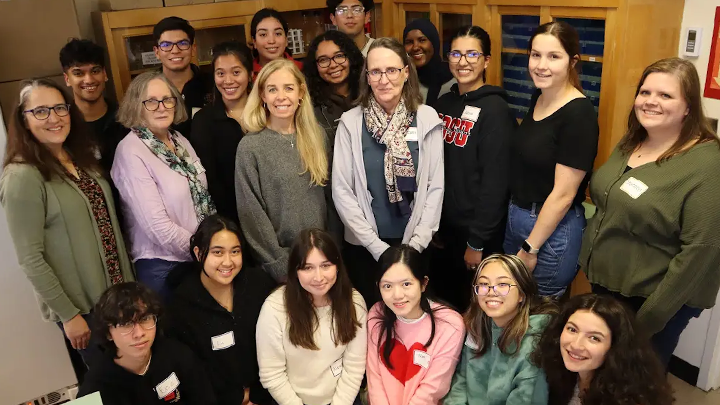
A National Science Foundation-funded project has brought together four principal investigators (PI) from institutions across the country to conduct research and promote underrepresented students in STEM at San Diego State University.
In 2022, SDSU’s Liz Waters , along with Elizabeth Vierling from University of Massachusetts Amherst, Paula Lemons from University of Georgia and Magdalena Bezanilla from Dartmouth College were awarded the grant to support four years of plant biology studies and STEM education.
To advance STEM education, the researchers formed the Biotech Scholars program, a learning community of fourteen first-generation or minority undergraduate students. The program, which started in September, provides students a paid opportunity to gain lab experience and insight necessary for future internships and jobs, with a goal of helping each student in the cohort attain a science research position this summer.
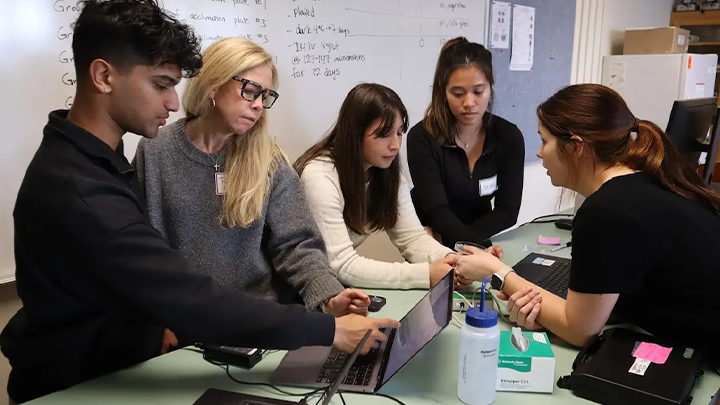
“Being here at SDSU for over 20 years, I realized that many students who did not have the opportunity to work in a lab for free were locked out of getting those first really fundamental opportunities outside of class that gave them the experience required to get that first real scientific job,” said Waters. “So we are trying to give them that paid experience at SDSU and then funnel them into paid biotech internships to get that foot in the door for their future careers.”
Throughout the academic year, students work in close collaboration with all the PIs on the grant, meeting twice a month and receiving career advice and resume help from biotech researchers across California. The program also involves a two-week “biotech boot camp” which, in alignment with the PIs’ research under this grant, is a lab experience focused on plant biology that allows students to grow their scientific expertise while forming a community of peers with similar interests.
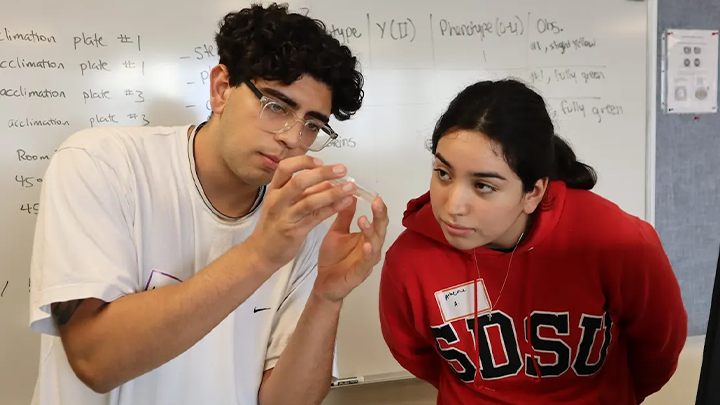
“The students are doing lab experiments where we teach them the techniques but we don’t know what the answer is,” said Waters. “So it is very different from a canned lab in a class where you just follow instructions and if you did it correctly, you get a certain answer.”
The first week of the boot camp, students investigated plant response to high temperature. By adding heat stress to the plants, students were able to measure the plants’ ability to undergo photosynthesis, which indicates the overall health of the plants.
The second week, they learned molecular techniques, including how to build plasmids to alter specific genes.
“During the lab boot camp, we introduced students to a variety of experiments in plant physiology and molecular biology using technology like CRISPR, while teaching them how to make observations and keep electronic notebooks,” said Vierling. “These skills are really important for working in the biotech industry.”

Here’s what students had to say about this opportunity:
Benae Tabancura, sophomore biology major “I’ve never been in a lab before outside of my courses. I already have another job so this opportunity allowed more flexibility than being a part of a year-long research lab. I learned a lot about specifically biology or STEM-based job applications because I've applied in the past for restaurant jobs and stuff but never anything relevant to my major. So it was cool to have people who have already done those things to guide me through that as we are all applying to internships for the summer.”
Jasmine Pooni, sophomore biology major “This is my first opportunity to do something like this. I found out about this program from my Bio 203 TA who told me I would be a great fit and that biotechnology can be used basically in any field of biology. It has been a really great experience of getting to learn new biological techniques and it’s also been a great community and an opportunity to make friends who are also Biology majors.”
Alex Sandoval, junior biology major “This biotech opportunity really opened my eyes to new possibilities and I wouldn’t be able to compare this program to much else that I have experienced. Some of the skills that Biotech@SDSU helped me develop include interviewing, analyzing scientific research papers and an array of laboratory techniques. The guidance provided by the mentors throughout the year has allowed me to gain the experience necessary to achieve that overarching goal of getting a summer internship in biotech.”
Dishant Vandra, sophomore kinesiology major “This opportunity enabled me to connect and network with plenty of professionals from different schools as well as professors here at SDSU. I've learned a lot about my interest in research and I definitely plan to take this forward in my career and hopefully apply it to other biotech jobs and internships.”
Gisele Chhoeuy, junior biology major “Before this program, I did not have any experience working in a lab setting other than our classes. We worked with parafilm and so much other stuff in the lab that we never got to do in class labs. I have really enjoyed this experience and I think it will be really good to put this on resumes for internships because it is something that is very relevant to our majors.”
So, far students in this program have been offered internships at the following institutions this summer:
- Salk Institute Summer Undergraduate Research Fellowship
- Summit Pathways Program Oregon Health Science University School of Dentistry
- Stanford University Baseball Science Core Biomechanics Research
- CSU Council on Ocean Affairs, Science & Technology (COAST) Internship
- Ocean Science Trust Internship
- University of Nevada at Las Vegas Summer Undergraduate Research Fellowship
- Dartmouth College Research Position
- Debut Biotech
The program will continue this fall with a new cohort of fourteen students. Those interested in this opportunity can reach out to Waters at [email protected] .
Campus News

- SDSU joins NASEM, contributing to sexual violence prevention efforts and research
- SDSU, Kumeyaay Community College sign partnership

- Aundrea Kaiser: My 'thank you' letter
- Jenae Dellafosse: My 'thank you' letter

- Gift to Aztec Rec Center is a commitment to a fit future
- San Diego couple’s gift ramps up SDSU Imperial Valley nursing program

IMAGES
VIDEO
COMMENTS
Photosynthesis (Google doc) Most life on Earth depends on photosynthesis .The process is carried out by plants, algae, and some types of bacteria, which capture energy from sunlight to produce oxygen (O 2) and chemical energy stored in glucose (a sugar). Herbivores then obtain this energy by eating plants, and carnivores obtain it by eating ...
Why is photosynthesis important? Photosynthesis is critical for the existence of the vast majority of life on Earth. It is the way in which virtually all energy in the biosphere becomes available to living things. As primary producers, photosynthetic organisms form the base of Earth's food webs and are consumed directly or indirectly by all ...
Photosynthesis is the process in which light energy is converted to chemical energy in the form of sugars. In a process driven by light energy, glucose molecules (or other sugars) are constructed from water and carbon dioxide, and oxygen is released as a byproduct. The glucose molecules provide organisms with two crucial resources: energy and ...
Photosynthesis is powered by energy from sunlight. This energy is used to rearrange atoms in carbon dioxide and water to make oxygen and sugars. Carbon dioxide and water are inputs of photosynthesis. These inputs come from the environment. Oxygen and sugars are outputs of photosynthesis. The oxygen is released into the environment.
What Is Photosynthesis? Why Is it Important? Most living things depend on photosynthetic cells to manufacture the complex organic molecules they require as a source of energy. Photosynthetic cells ...
Meaning. Photosynthesis. The process by which plants, algae, and some bacteria convert light energy to chemical energy in the form of sugars. Photoautotroph. An organism that produces its own food using light energy (like plants) ATP. Adenosine triphosphate, the primary energy carrier in living things. Chloroplast.
Figure 8.1.6 8.1. 6: Photosynthesis takes place in two stages: light dependent reactions and the Calvin cycle. Light-dependent reactions, which take place in the thylakoid membrane, use light energy to make ATP and NADPH. The Calvin cycle, which takes place in the stroma, uses energy derived from these compounds to make GA3P from CO 2.
Photosynthesis ( / ˌfoʊtəˈsɪnθəsɪs / FOH-tə-SINTH-ə-sis) [1] is a system of biological processes by which photosynthetic organisms, such as most plants, algae, and cyanobacteria, convert light energy, typically from sunlight, into the chemical energy necessary to fuel their activities.
photosynthesis: the process by which plants and other photoautotrophs generate carbohydrates and oxygen from carbon dioxide, water, and light energy in chloroplasts. photoautotroph: an organism that can synthesize its own food by using light as a source of energy. chemoautotroph: a simple organism, such as a protozoan, that derives its energy ...
At the end of photosynthesis, a plant ends up with glucose (C 6 H 12 O 6), oxygen (O 2) and water (H 2 O). The glucose molecule goes on to bigger things. It can become part of a long-chain molecule, such as cellulose; that's the chemical that makes up cell walls. Plants also can store the energy packed in a glucose molecule within larger ...
By Laurie Brenner. Photosynthesis is important to living organisms because it is the number one source of oxygen in the atmosphere. Without photosynthesis, the carbon cycle could not occur, oxygen-requiring life would not survive and plants would die. Green plants and trees use photosynthesis to make food from sunlight, carbon dioxide and water ...
5.1: Overview of Photosynthesis. All living organisms on earth consist of one or more cells. Each cell runs on the chemical energy found mainly in carbohydrate molecules (food), and the majority of these molecules are produced by one process: photosynthesis. Through photosynthesis, certain organisms convert solar energy (sunlight) into chemical ...
Photosynthesis is critical for the existence of the vast majority of life on Earth. It is the way in which virtually all energy in the biosphere becomes available to living things. As primary producers, photosynthetic organisms form the base of Earth's food webs and are consumed directly or indirectly by all higher life-forms. Additionally ...
Solar Dependence and Food Production. Some organisms can carry out photosynthesis, whereas others cannot. An autotroph is an organism that can produce its own food. The Greek roots of the word autotroph mean "self" (auto) "feeder" (troph).Plants are the best-known autotrophs, but others exist, including certain types of bacteria and algae (). ...
Photosynthesis is really important for the plant because it provides the plant with food: some of the glucose is used immediately, to give the plant energy in the process of respiration. some of ...
The whole process of photosynthesis is a transfer of energy from the Sun to a plant. In each sugar molecule created, there is a little bit of the energy from the Sun, which the plant can either use or store for later. Imagine a pea plant. If that pea plant is forming new pods, it requires a large amount of sugar energy to grow larger.
Photosynthesis is a vital process that converts light energy into chemical energy and produces organic molecules and oxygen for living things. In this article, you will learn how photosynthesis works in different ecosystems, how it affects the carbon cycle, and how it interacts with other biogeochemical cycles. Khan Academy is a free online platform that offers high-quality education for ...
Photosynthesis: What is it and how does it work? - BBC Science Focus Magazine.
Photosynthesis is a multi-step process that requires sunlight, carbon dioxide (which is low in energy), and water as substrates (Figure 3). After the process is complete, it releases oxygen and produces glyceraldehyde-3-phosphate (GA3P), simple carbohydrate molecules (which are high in energy) that can subsequently be converted into glucose, sucrose, or any of dozens of other sugar molecules.
CAM photosynthesis helps plants conserve water because leaf stomata are only open at night, when it's cooler and more humid. The disadvantage is the plant can only produce glucose from the stored carbon dioxide. Because less glucose is produced, desert plants using CAM photosynthesis tend to grow very slowly. 09.
Photosynthesis. Photosynthesis is the processes of using sunlight to convert chemical compounds (specifically carbon dioxide and water) into food. Photosynthesizing organisms (plants, algae, and bacteria) provide most of the chemical energy that flows through the biosphere. They also produced most of the biomass that led to the fossil fuels ...
Therefore, directly or indirectly, the process of photosynthesis provides most of the energy required by living things on earth. Photosynthesis also results in the release of oxygen into the atmosphere. In short, to eat and breathe, humans depend almost entirely on the organisms that carry out photosynthesis. ... it is important to become ...
Tuesday, May 14, 2024. The four principal investigators who manage the Biotech Scholars program pose for a photo in the lab with their cohort of fourteen undergraduate students. A National Science Foundation-funded project has brought together four principal investigators (PI) from institutions across the country to conduct research and promote ...